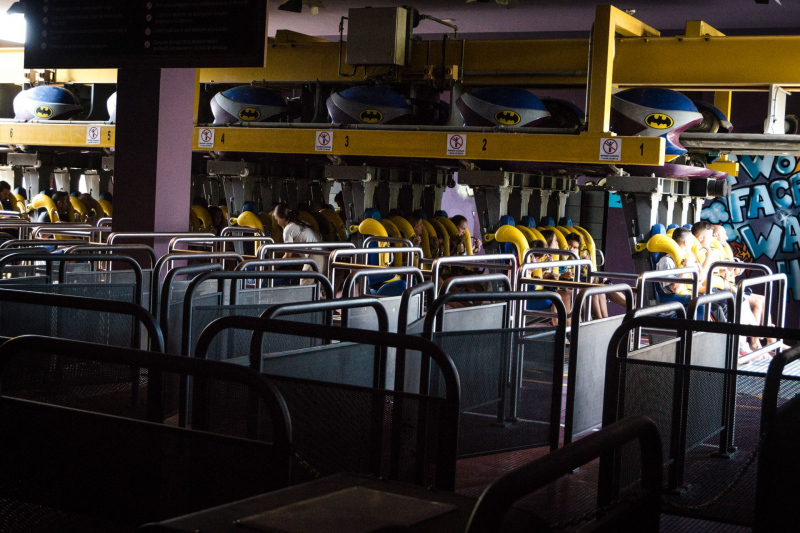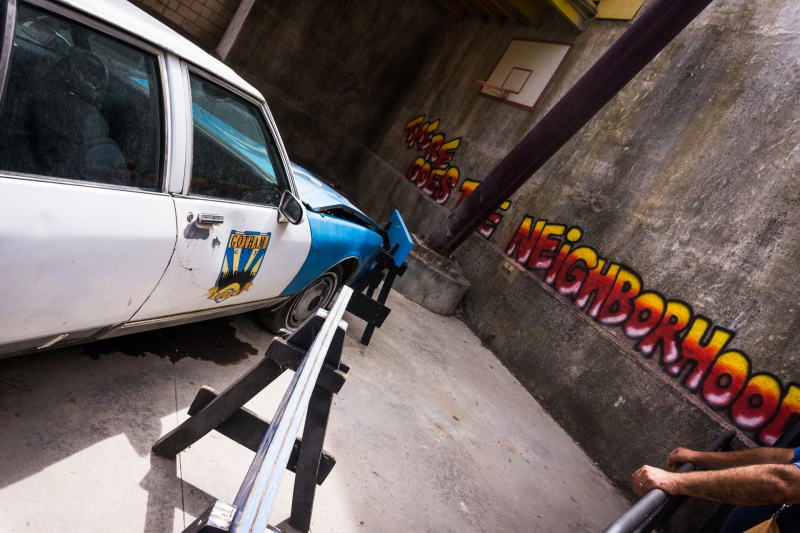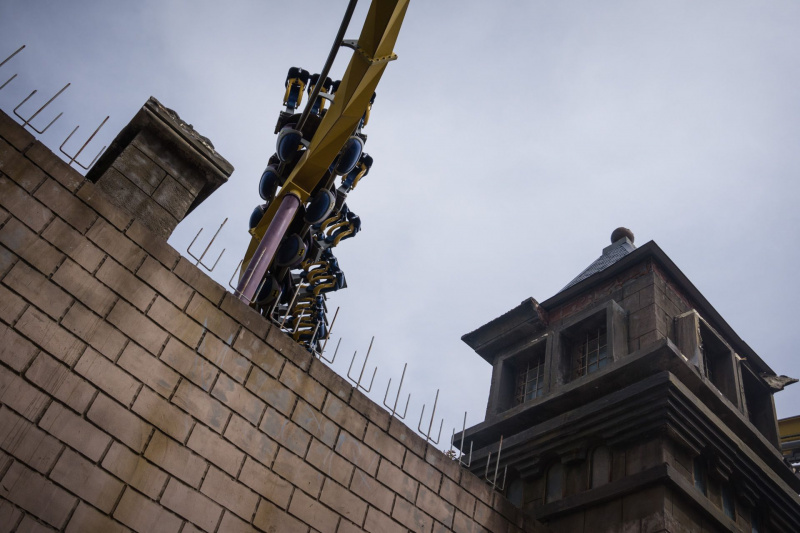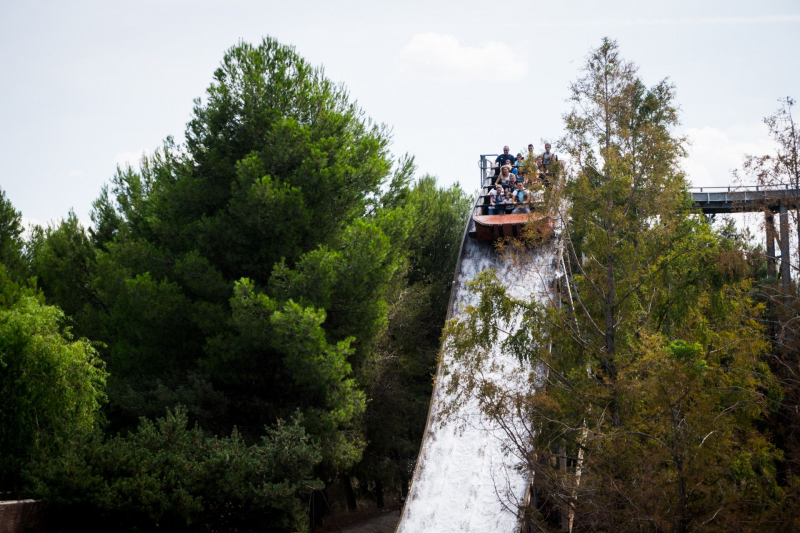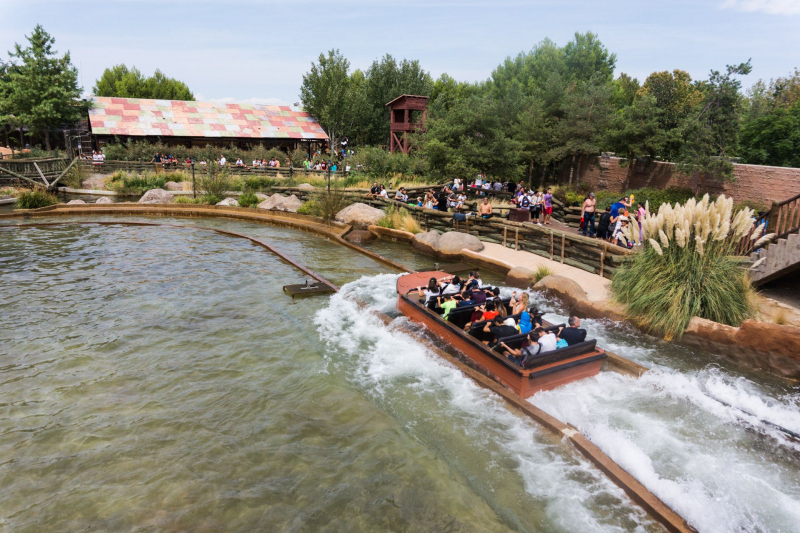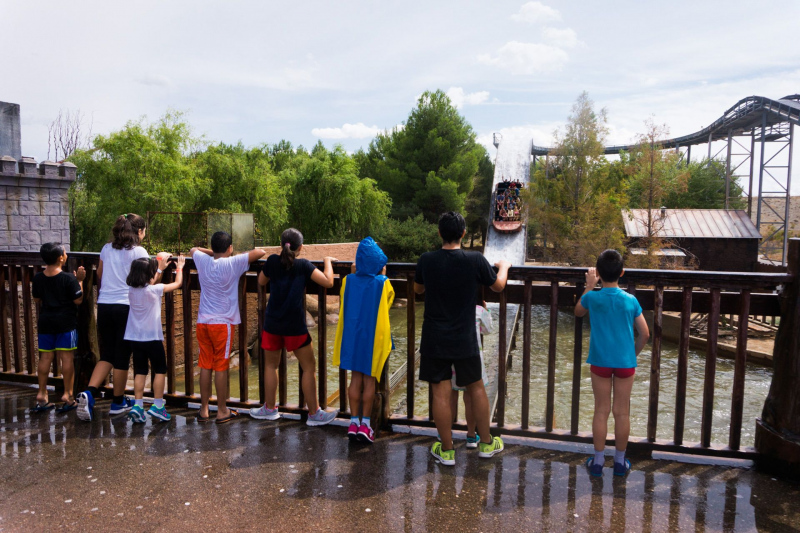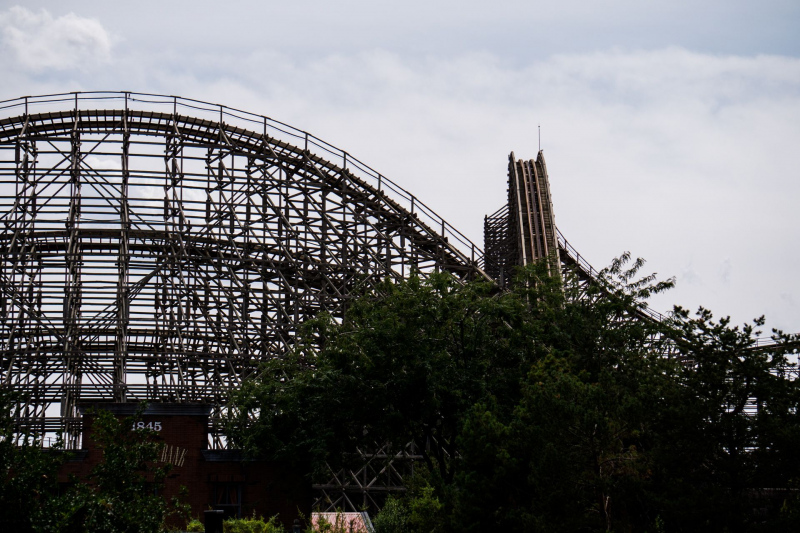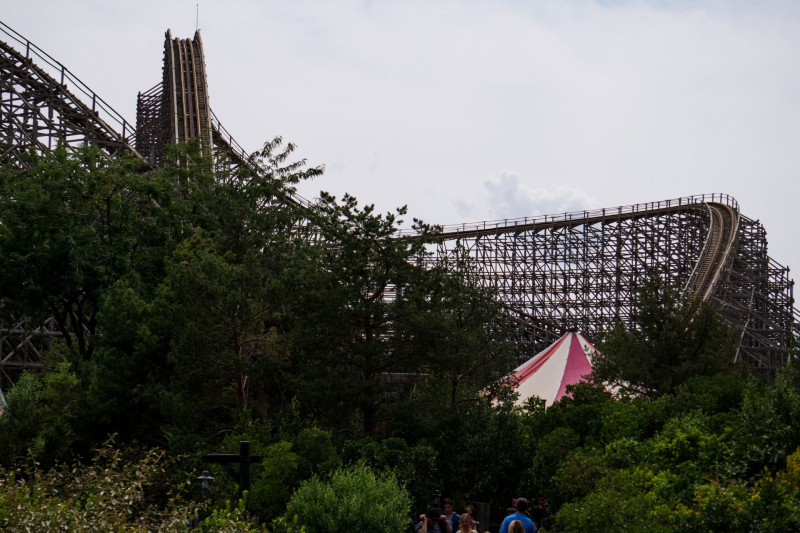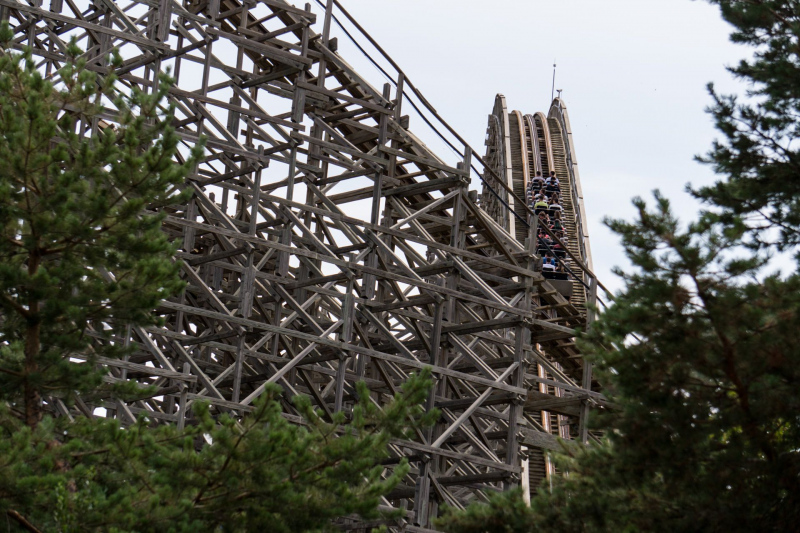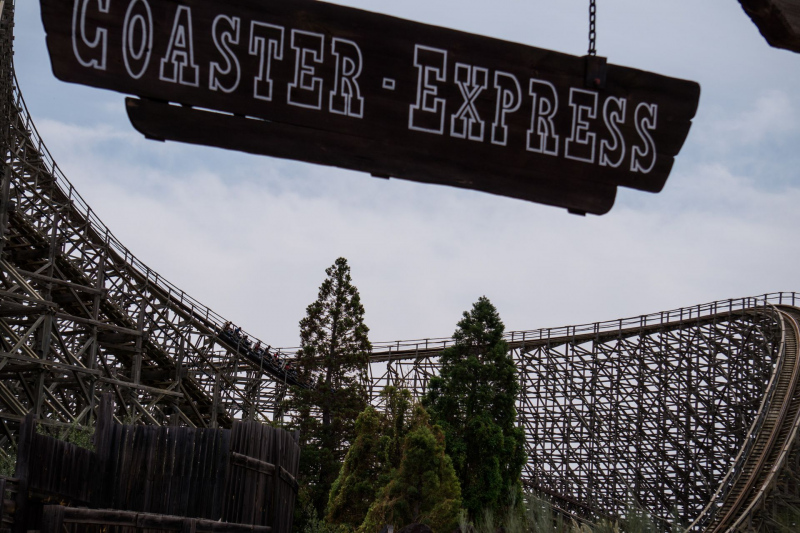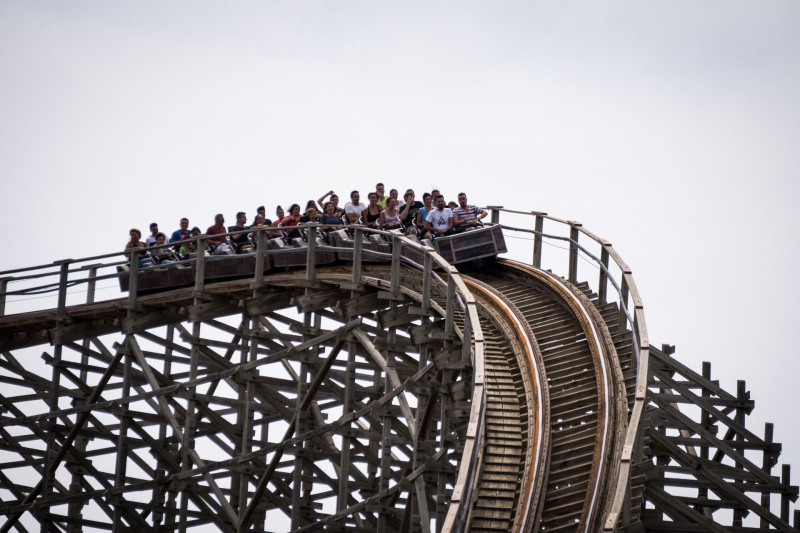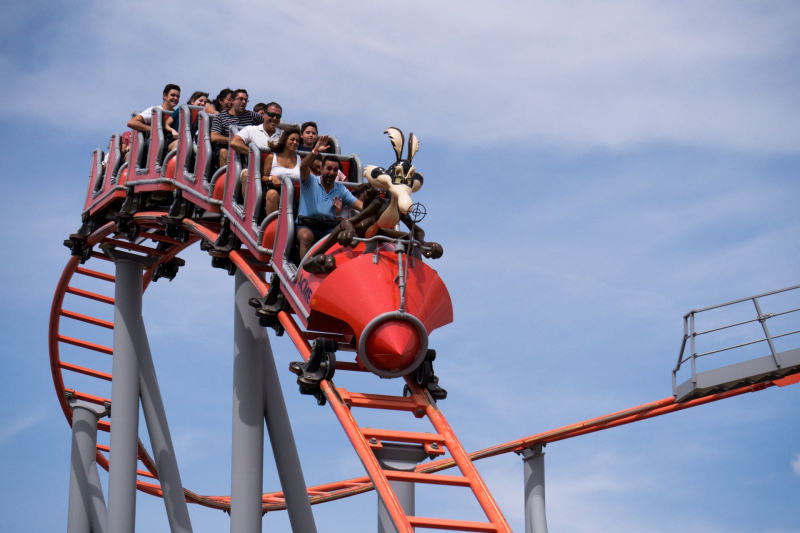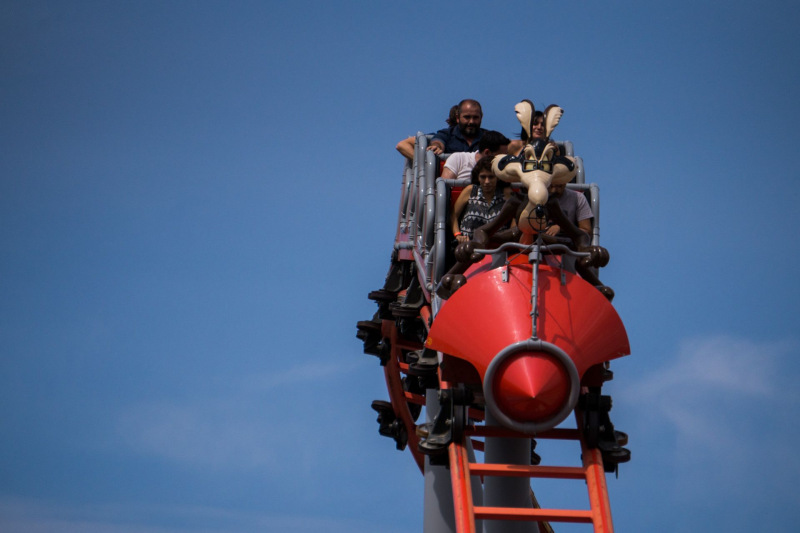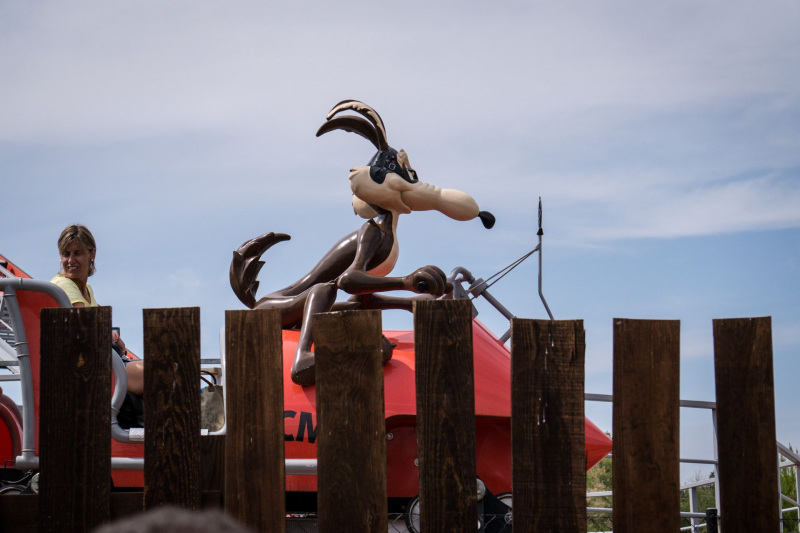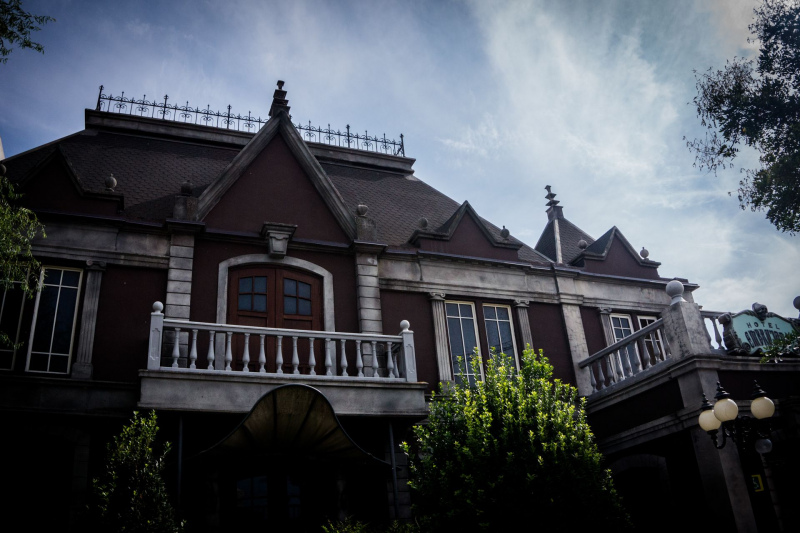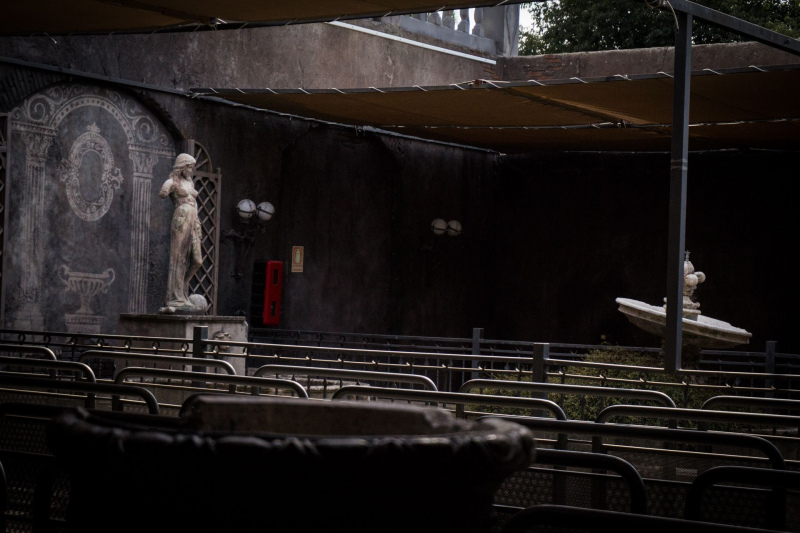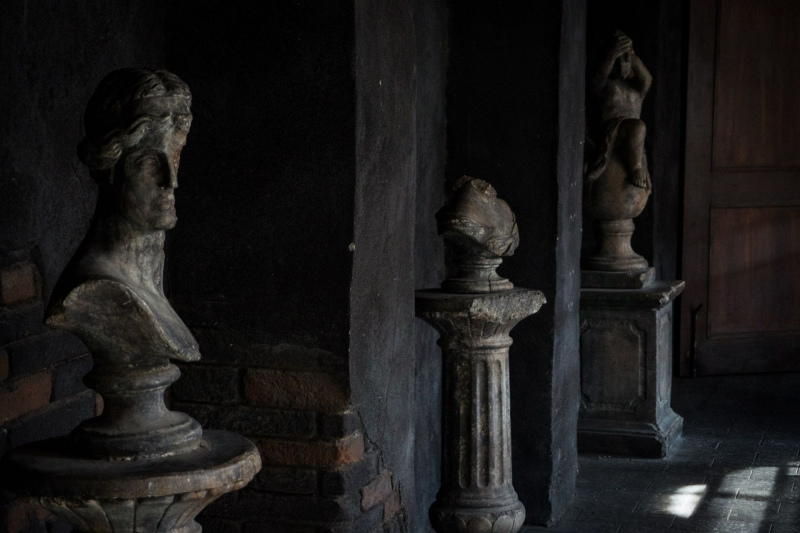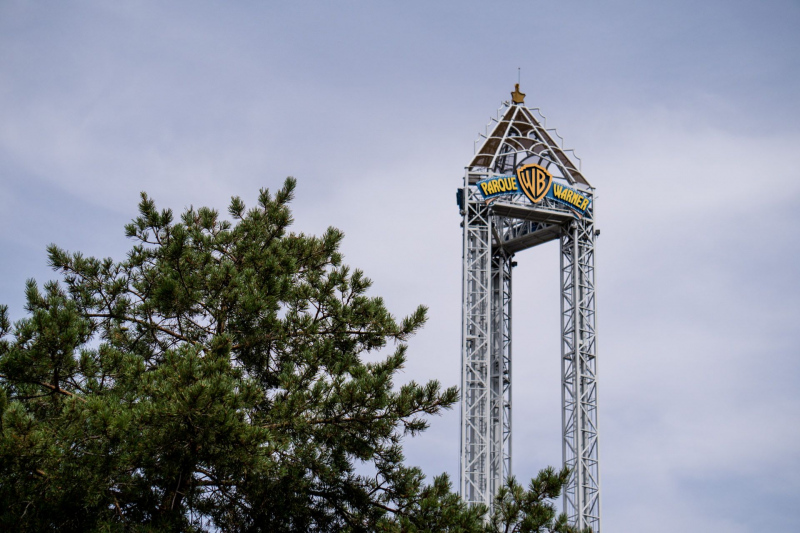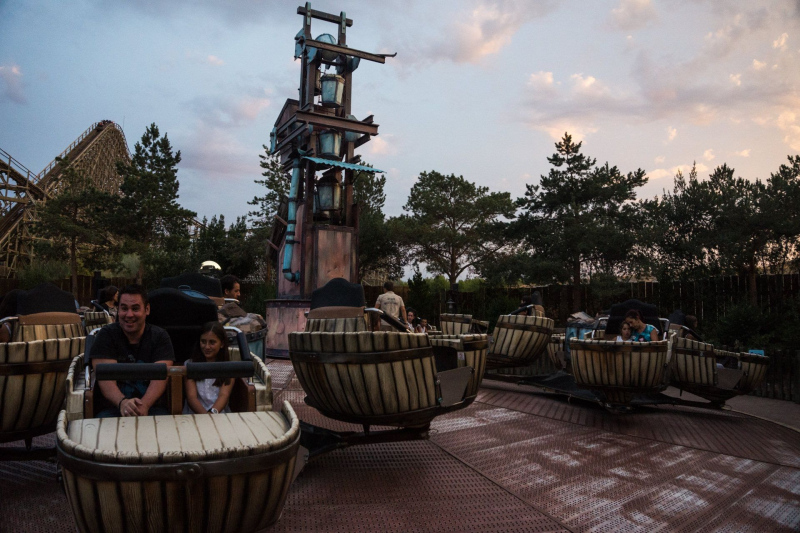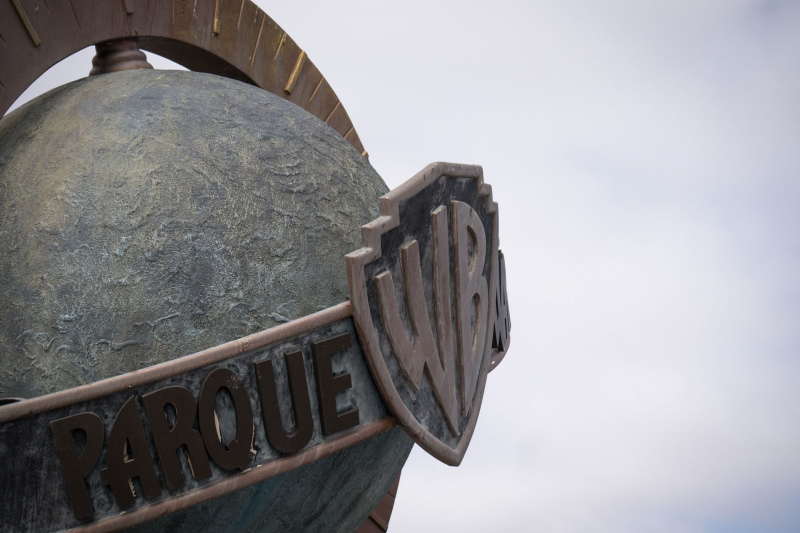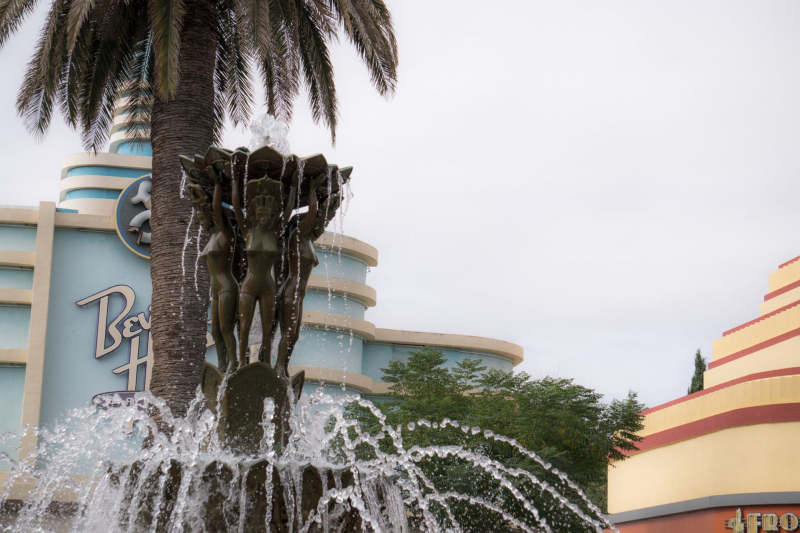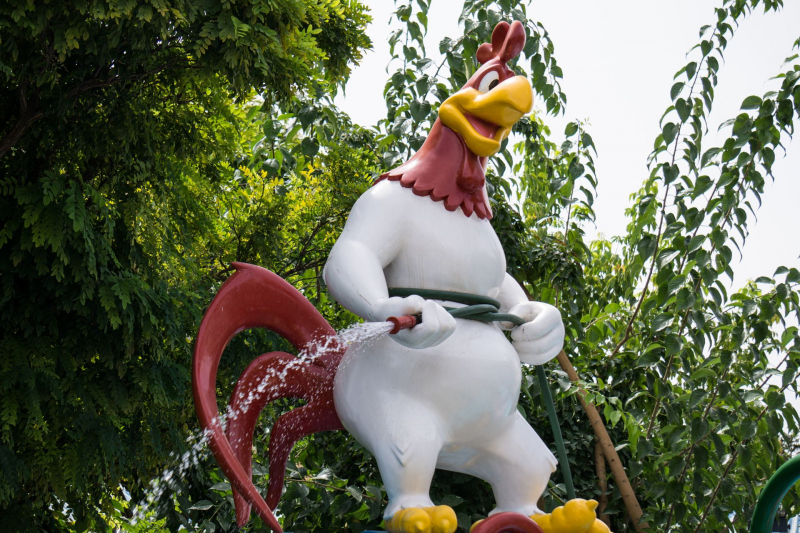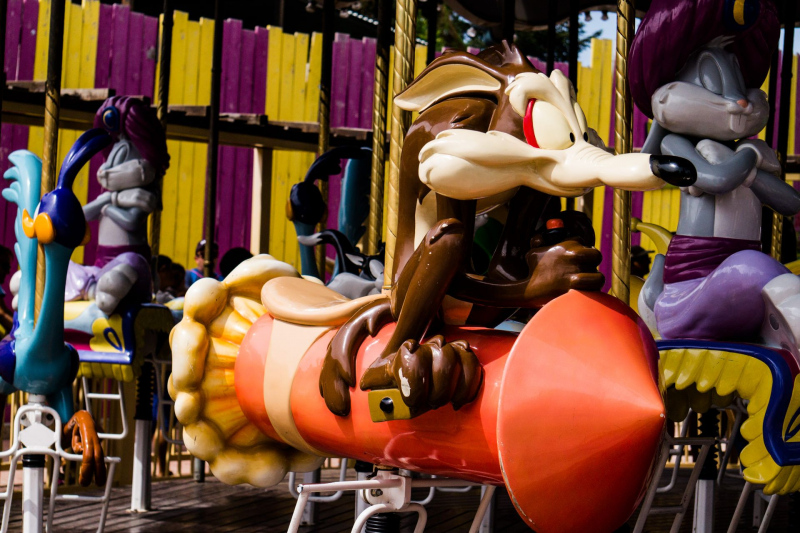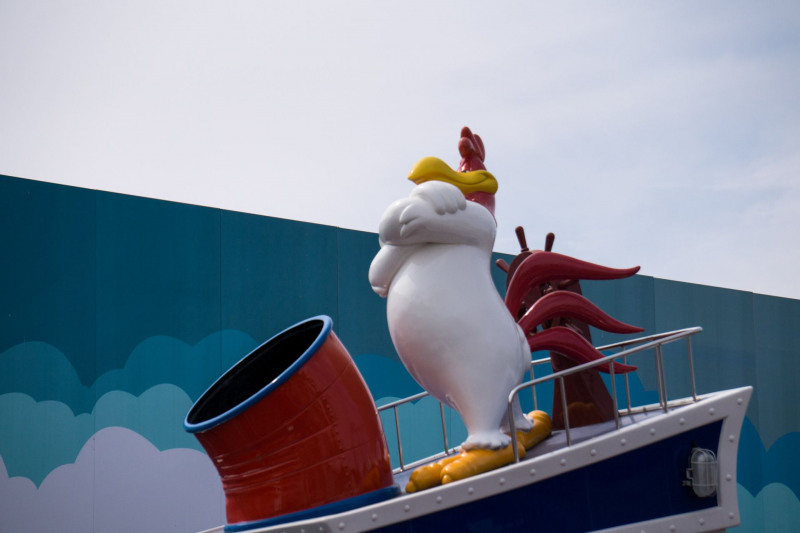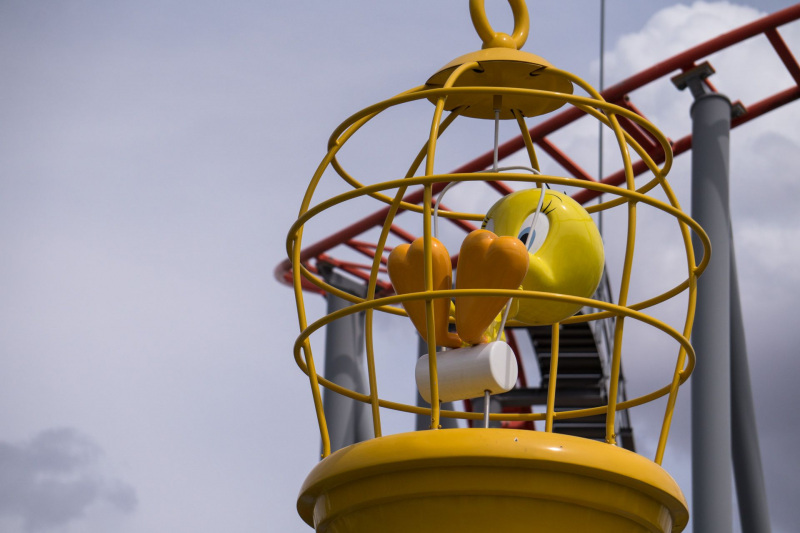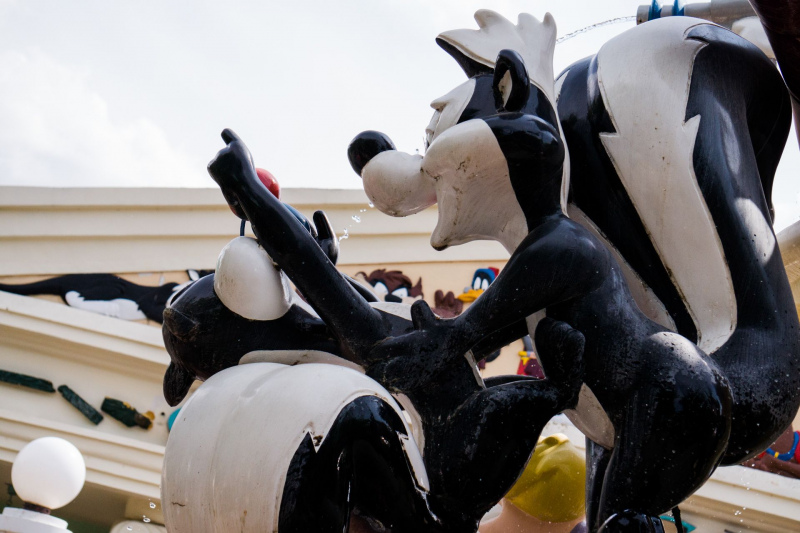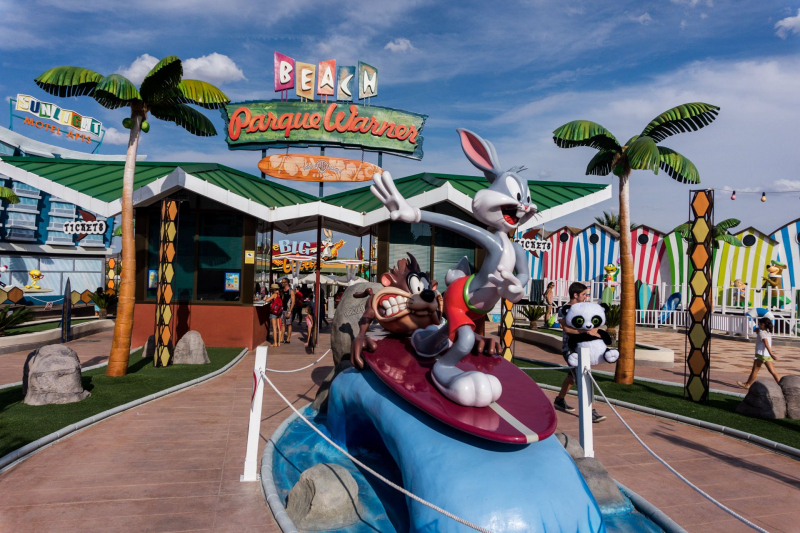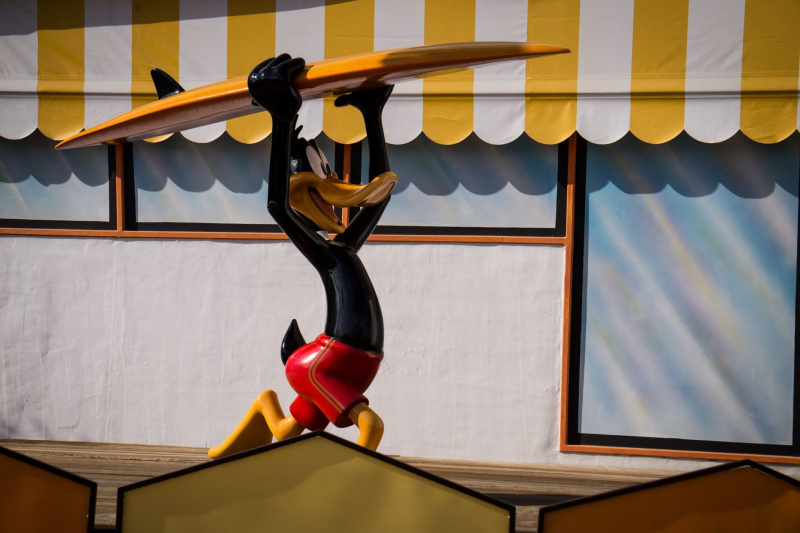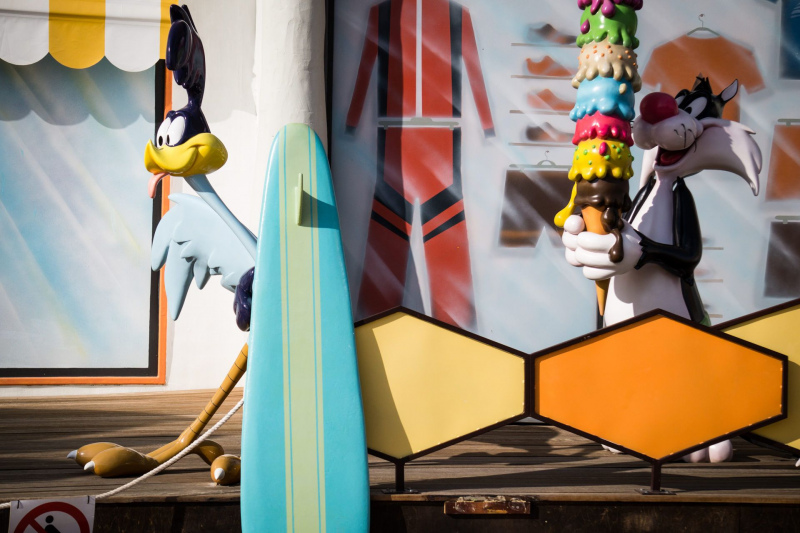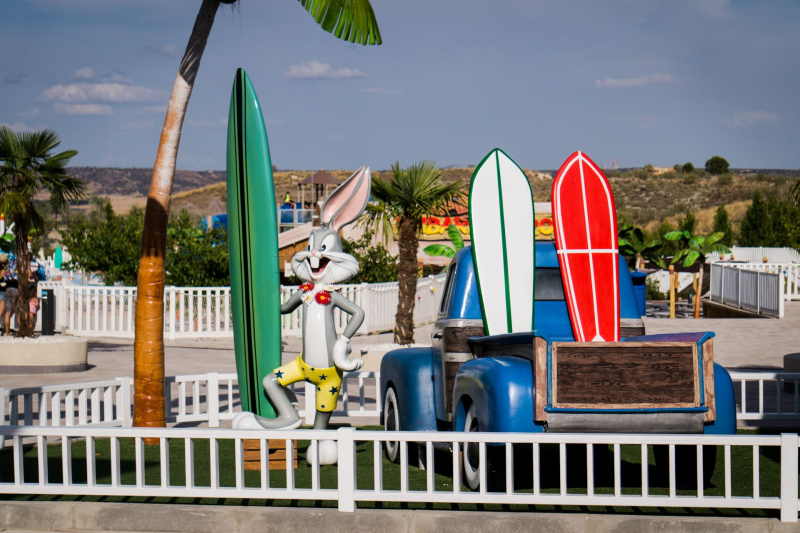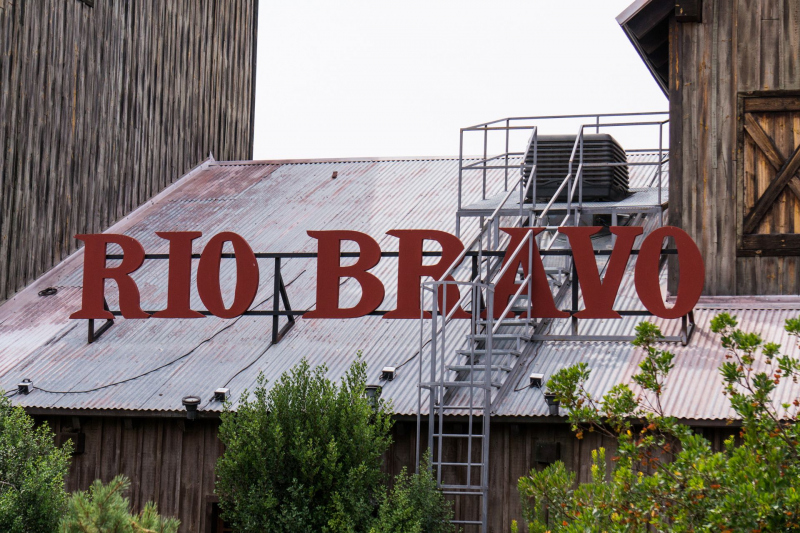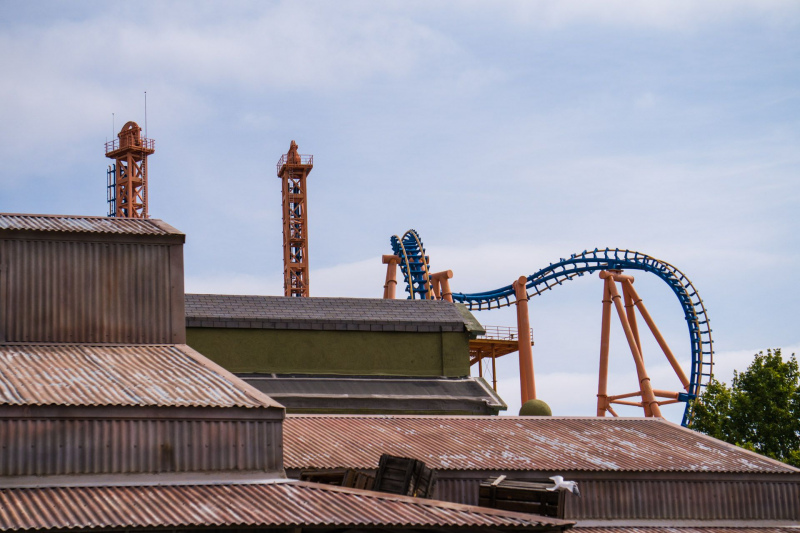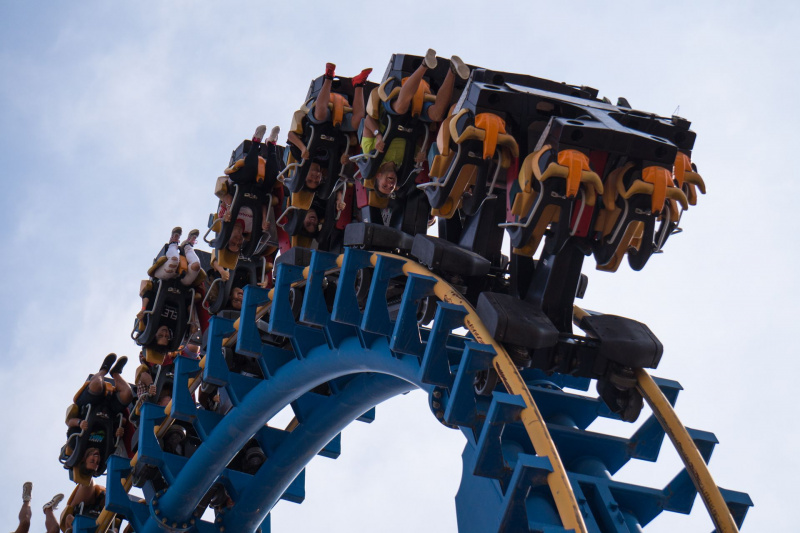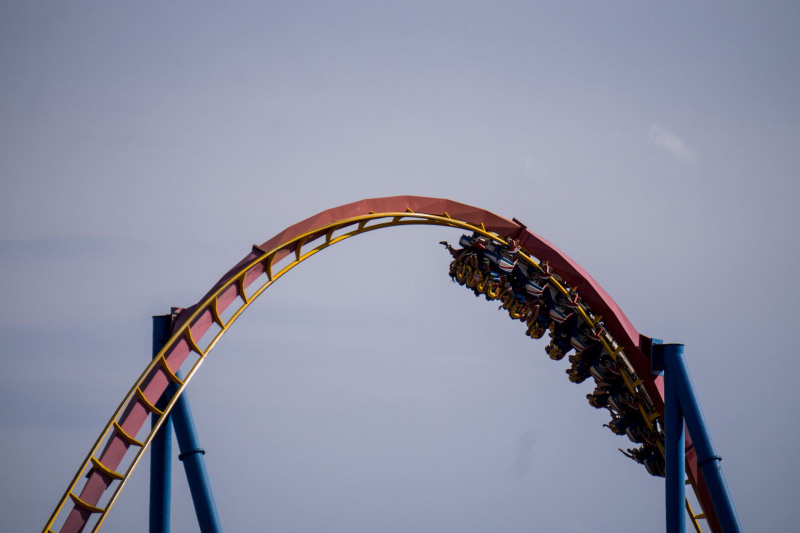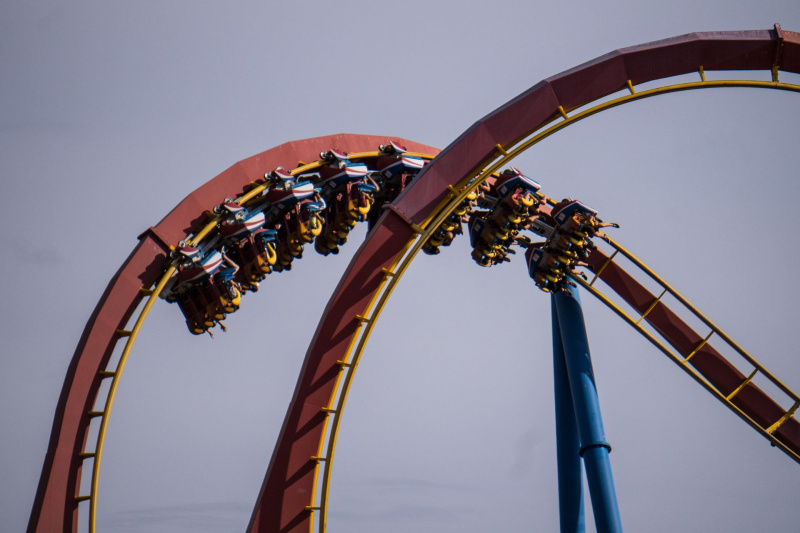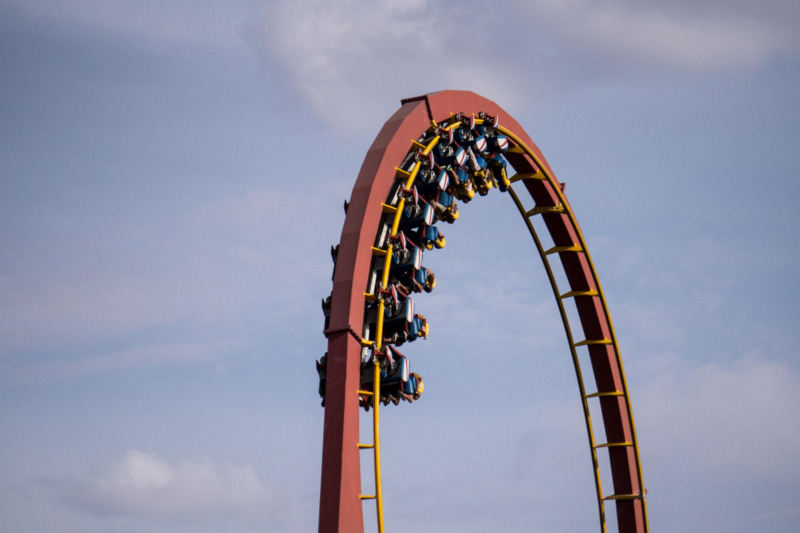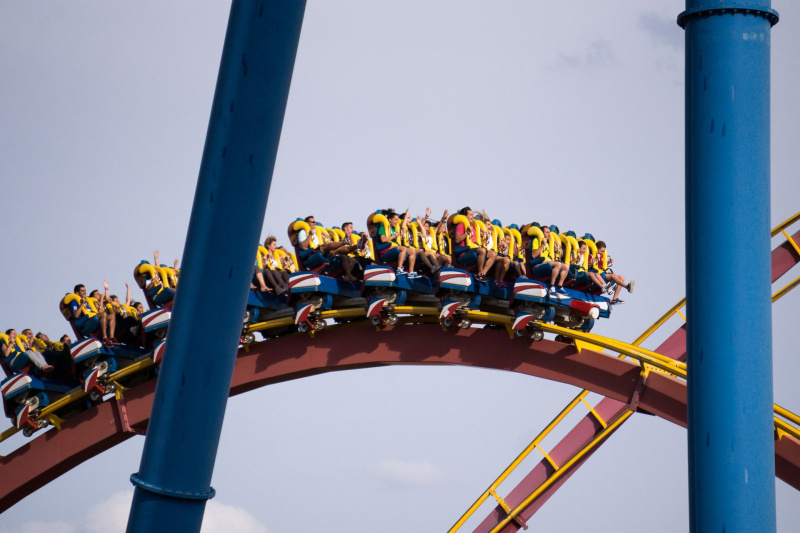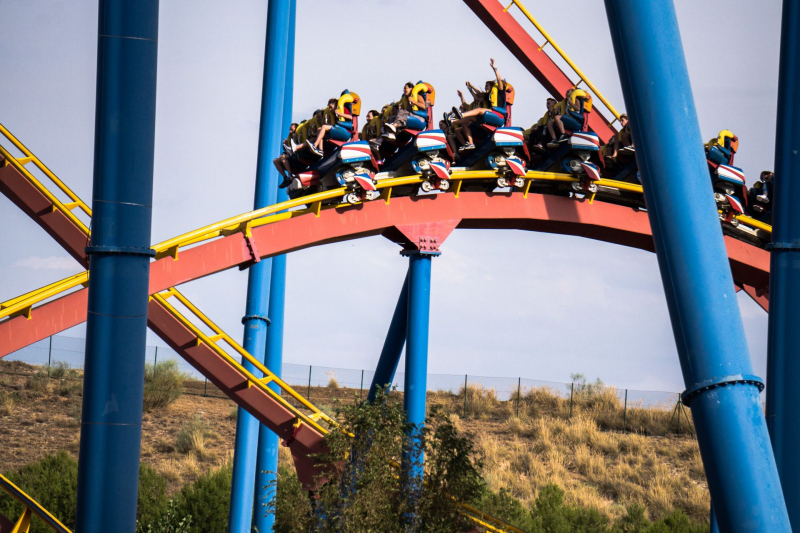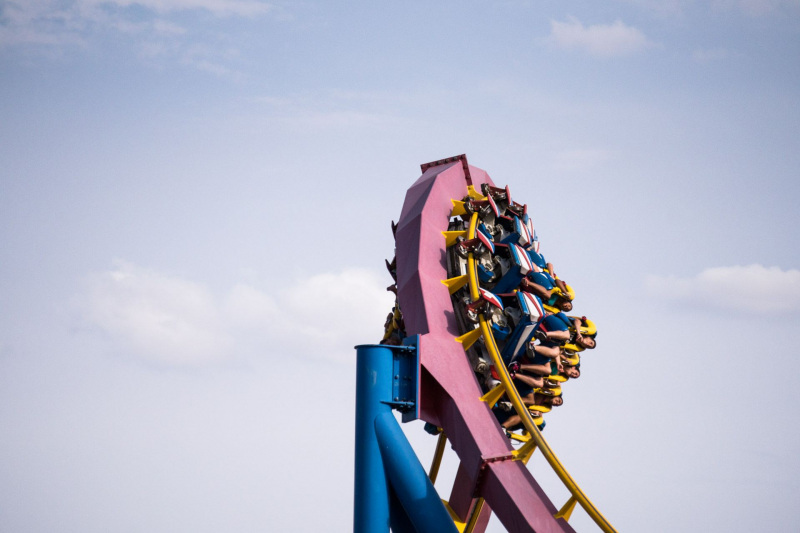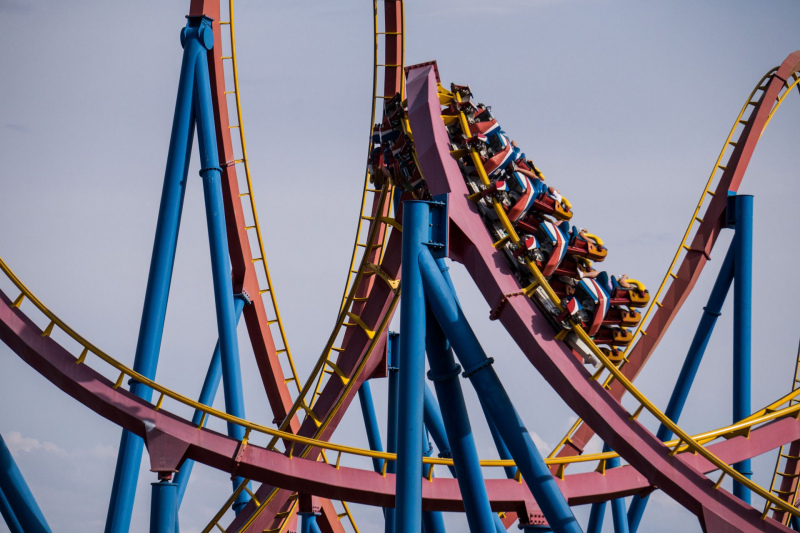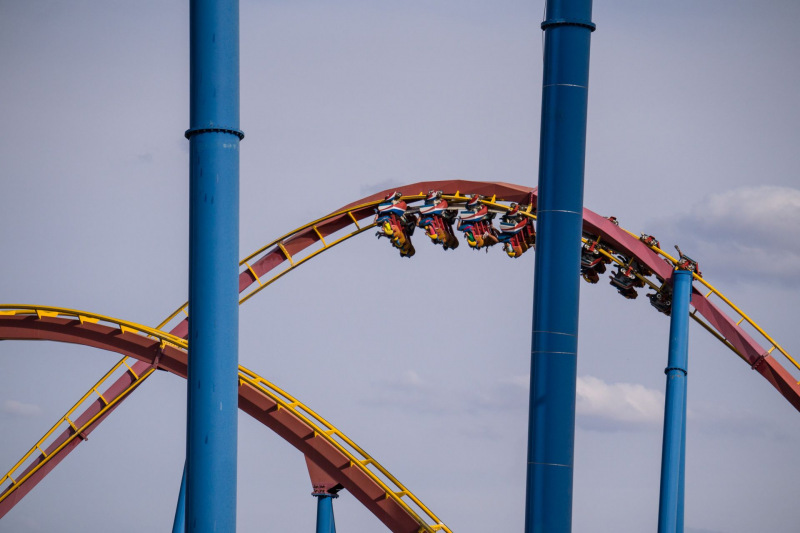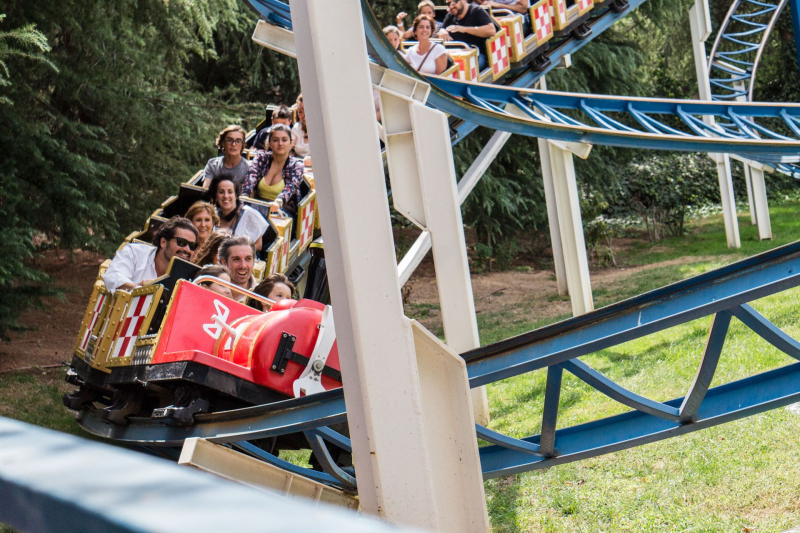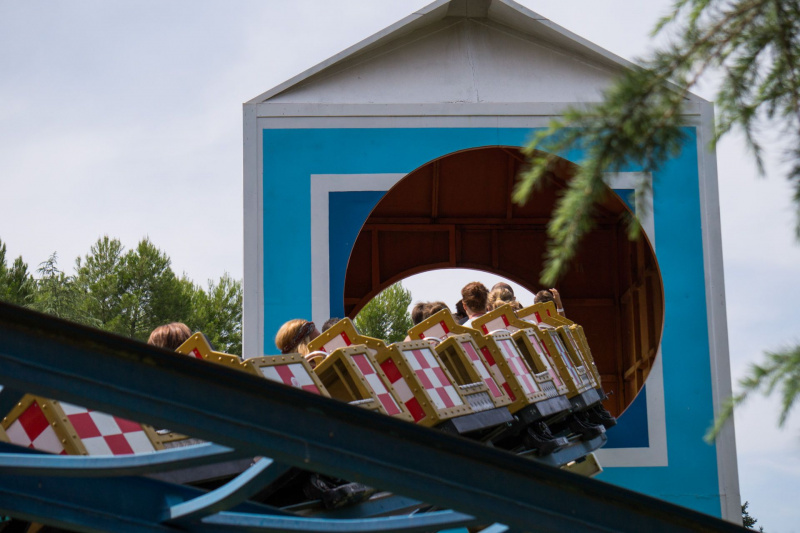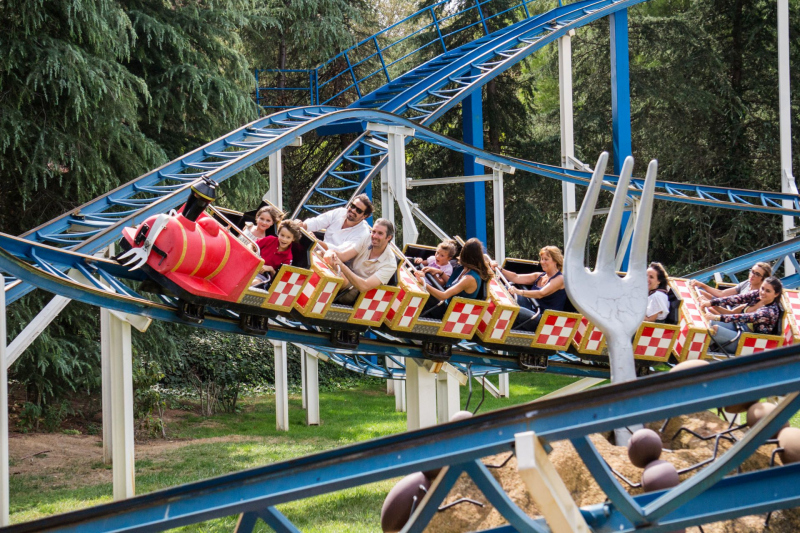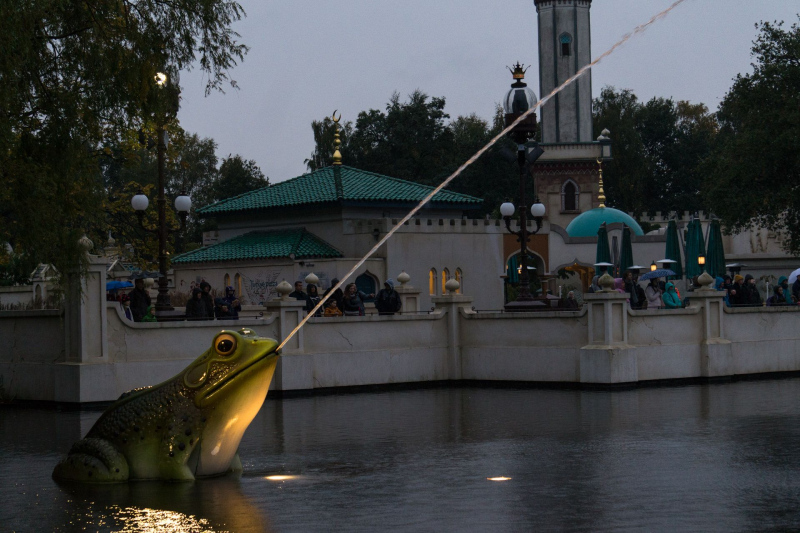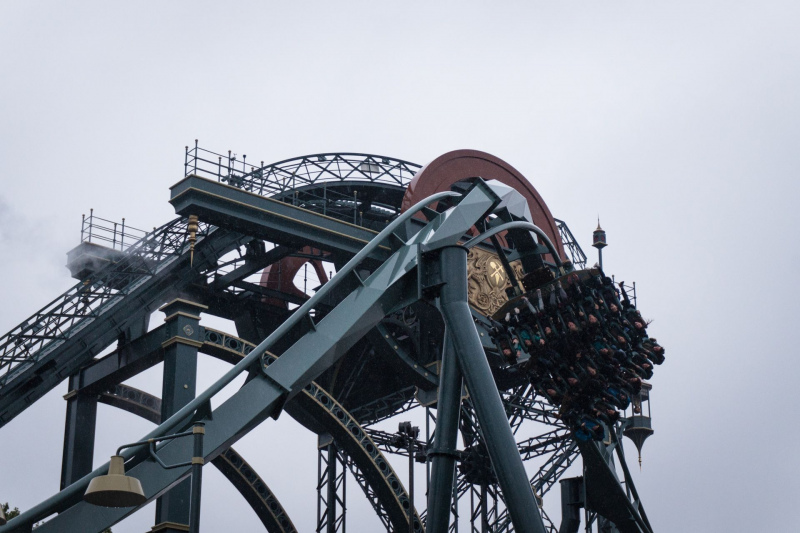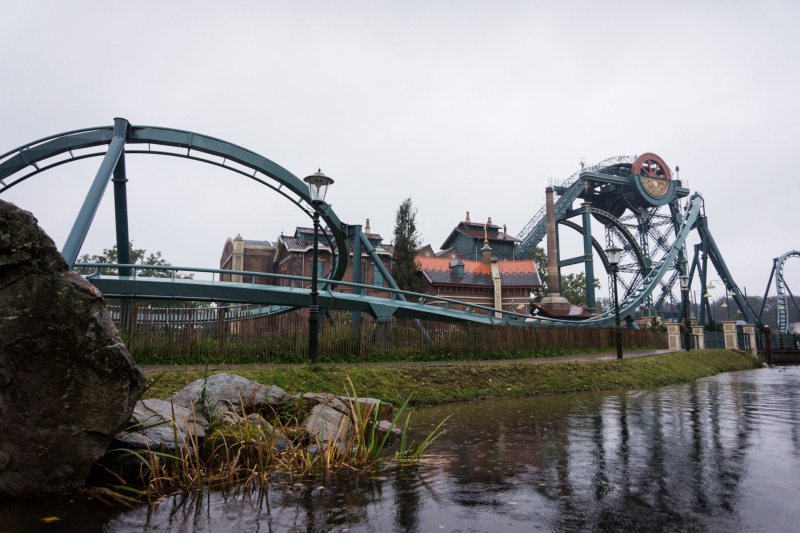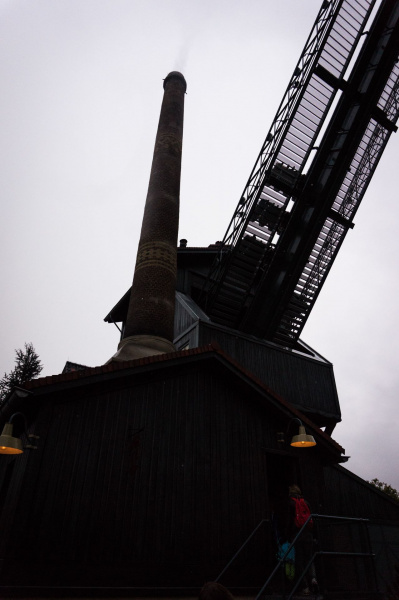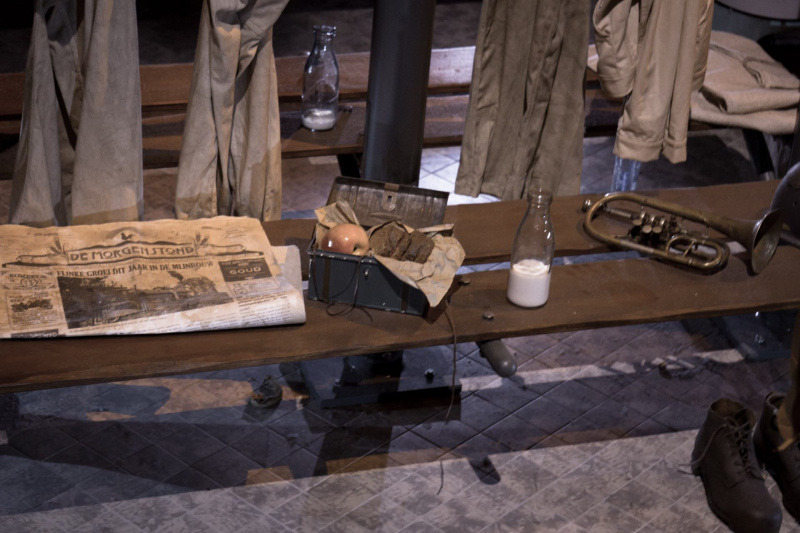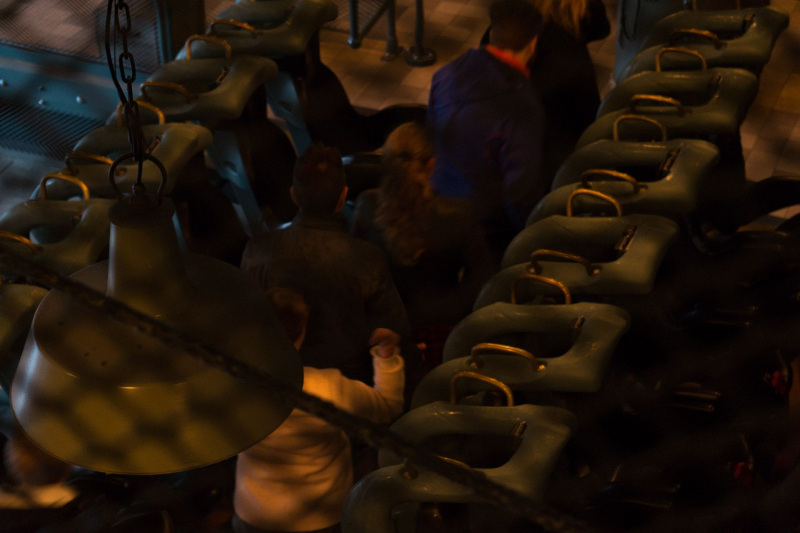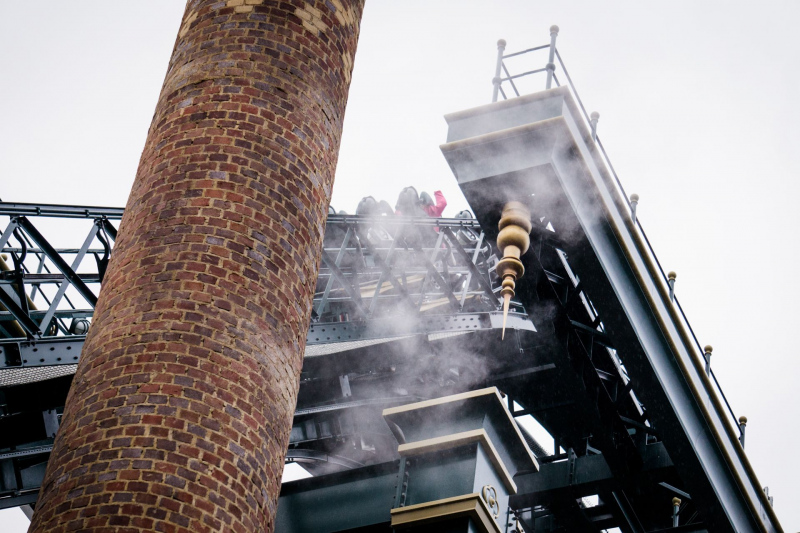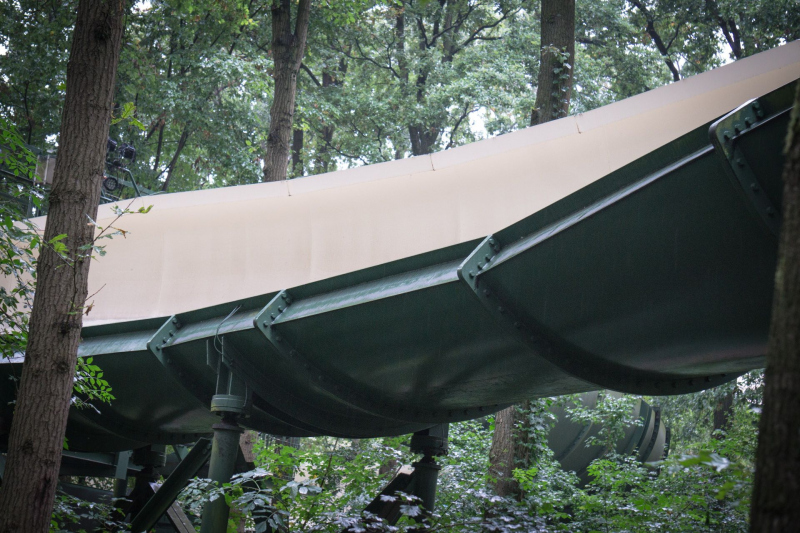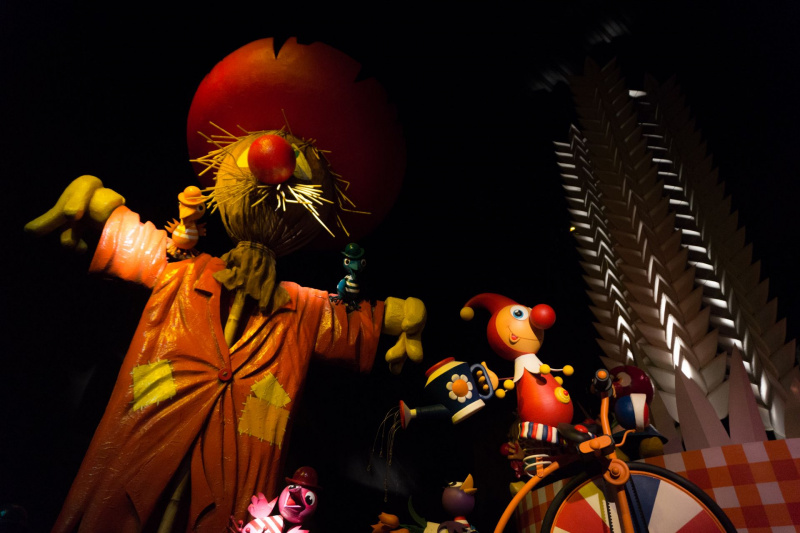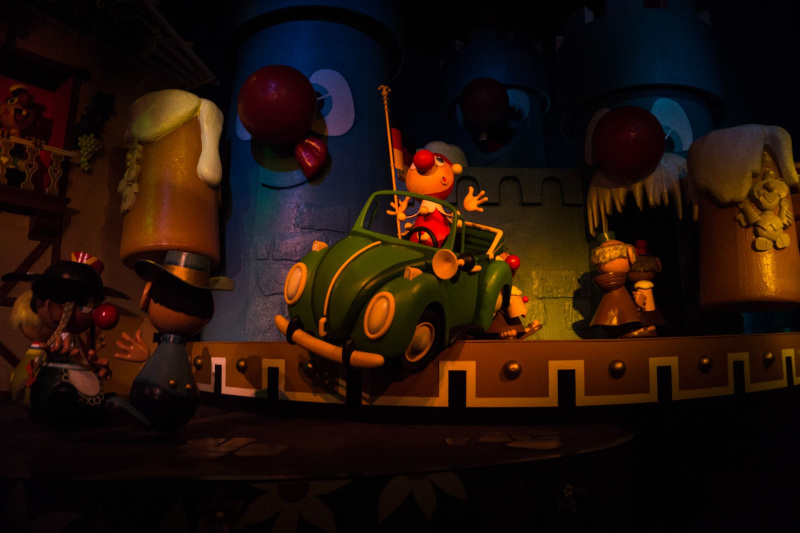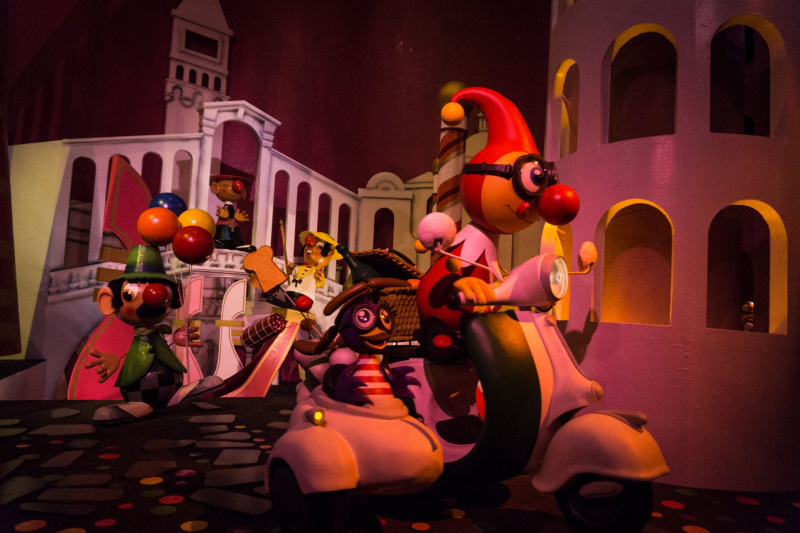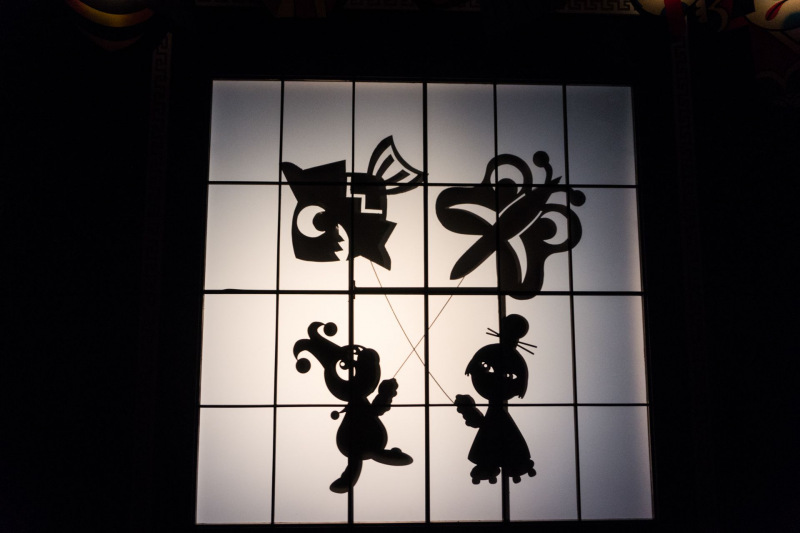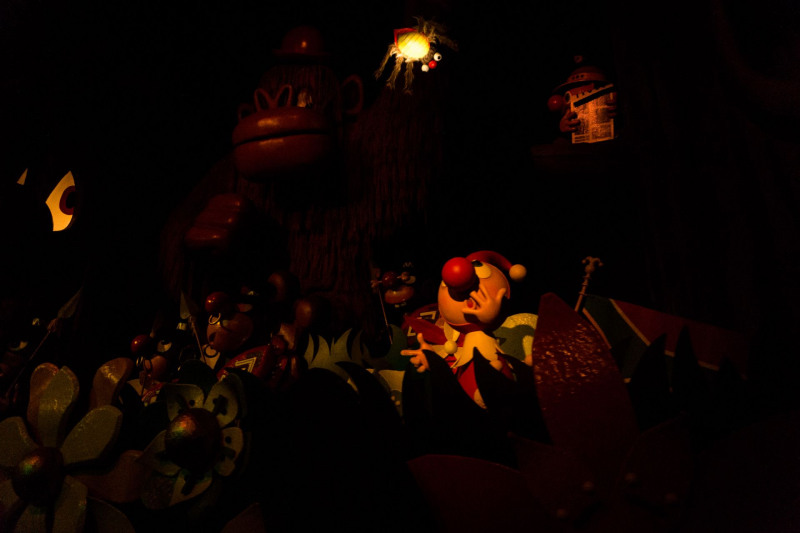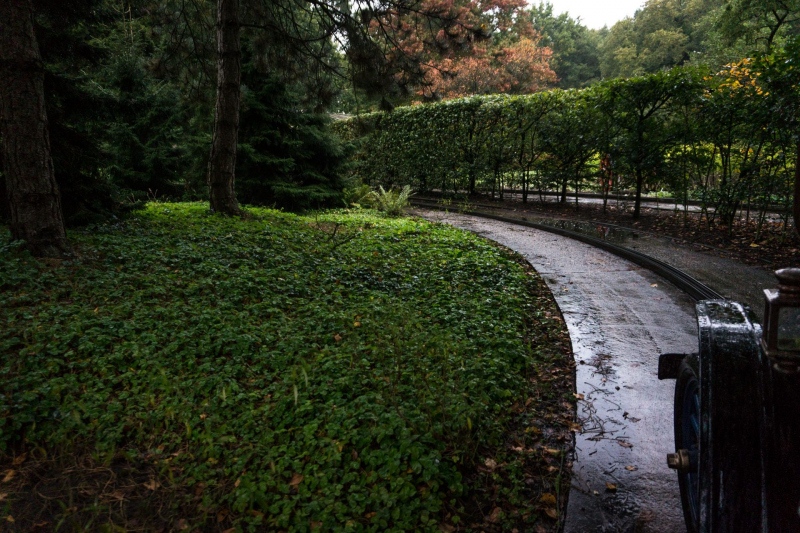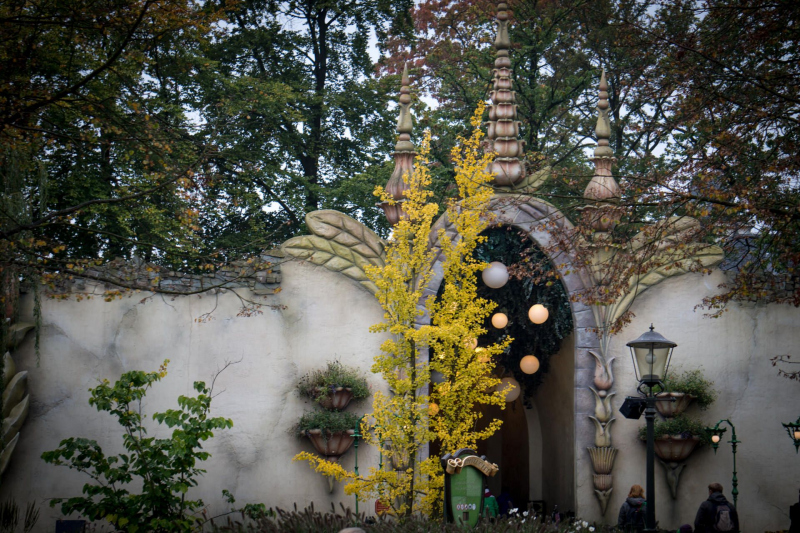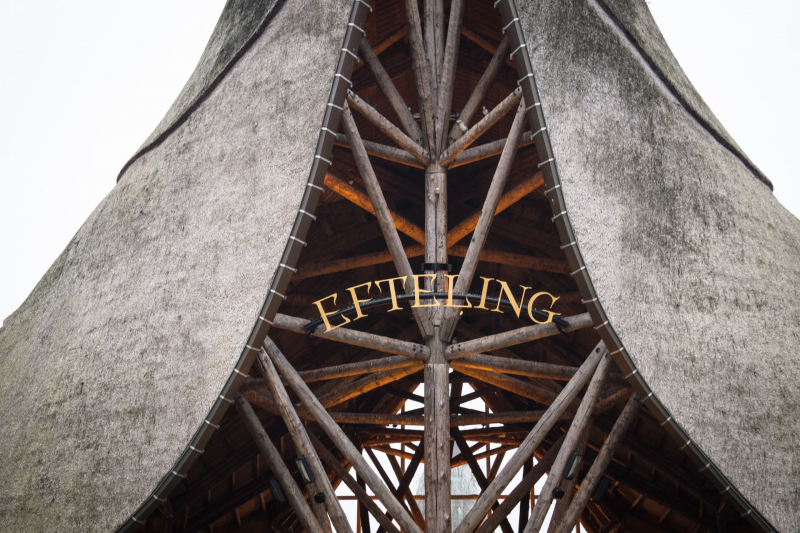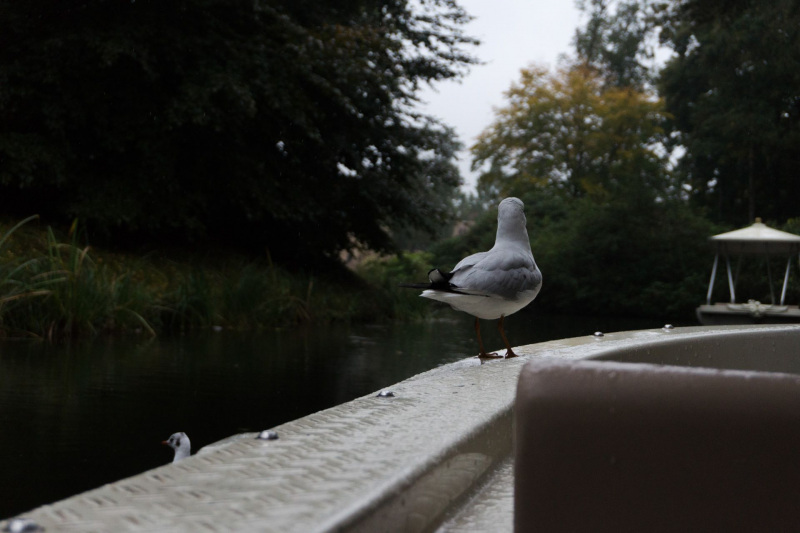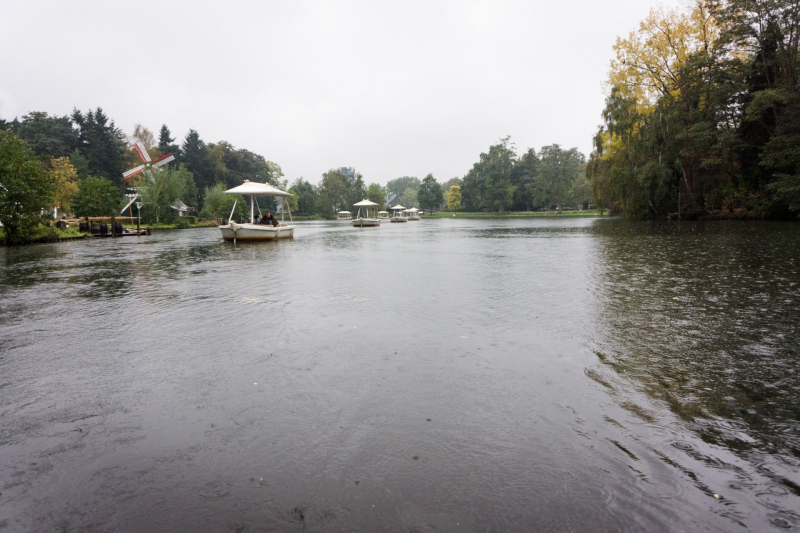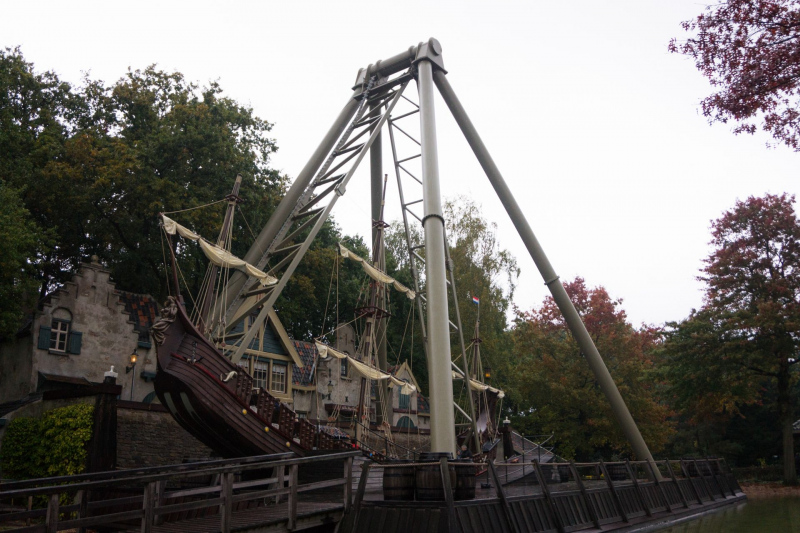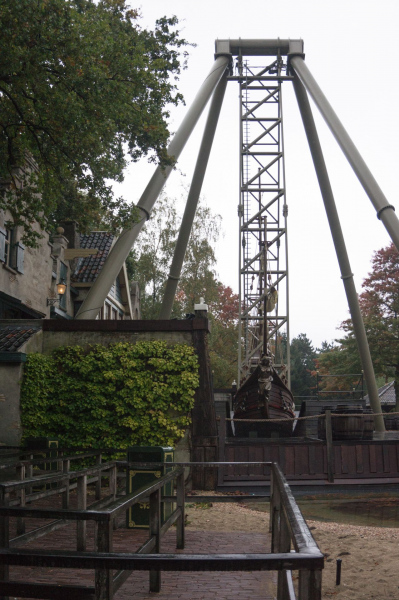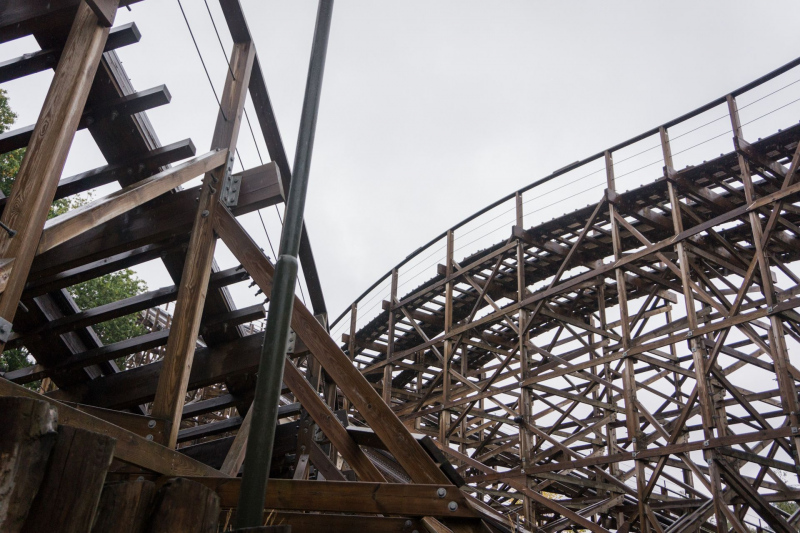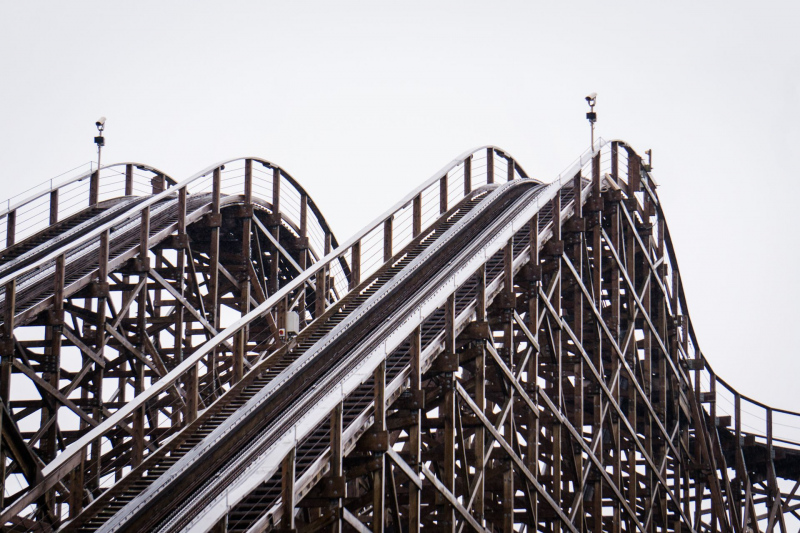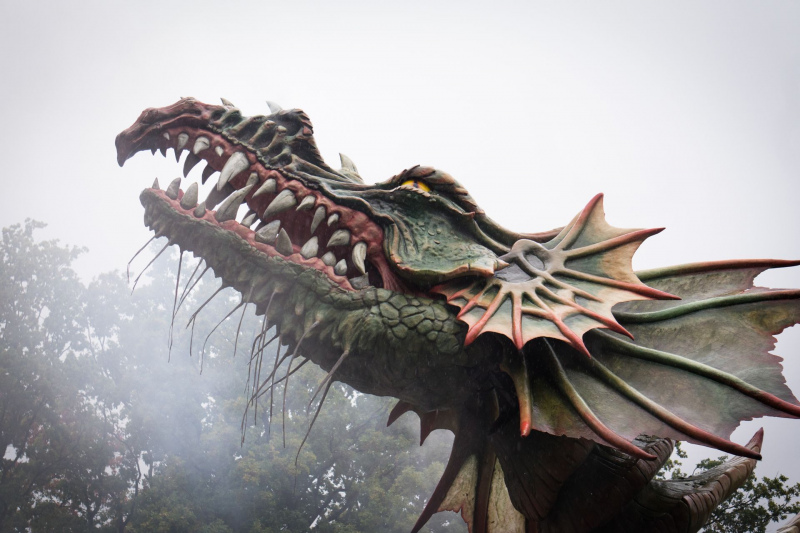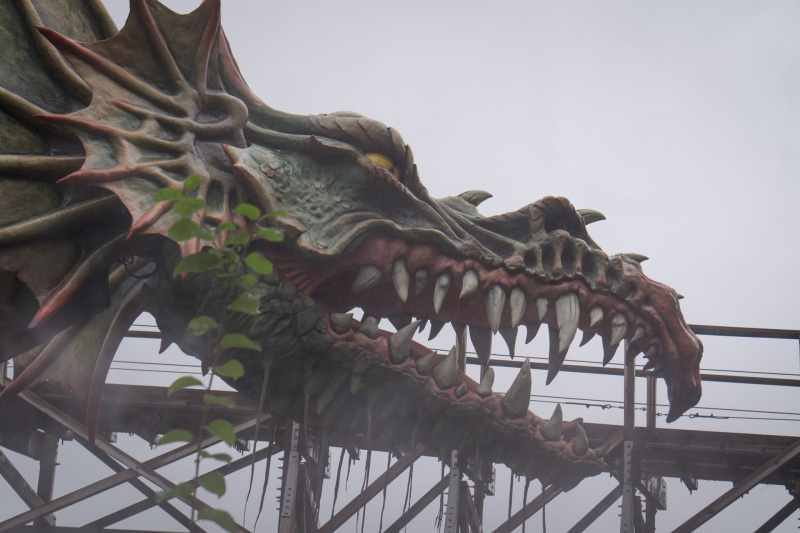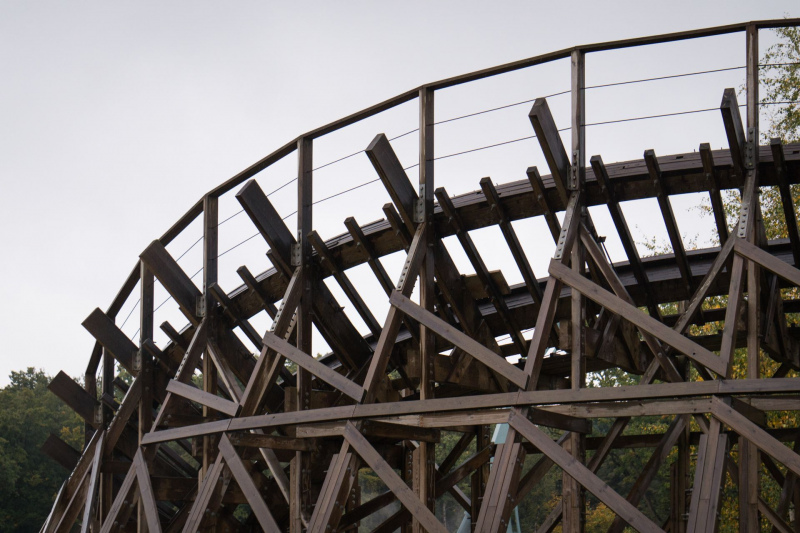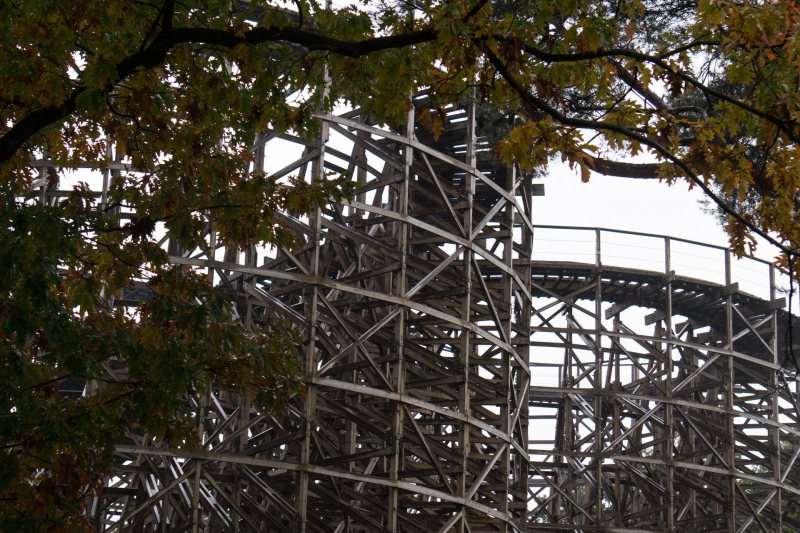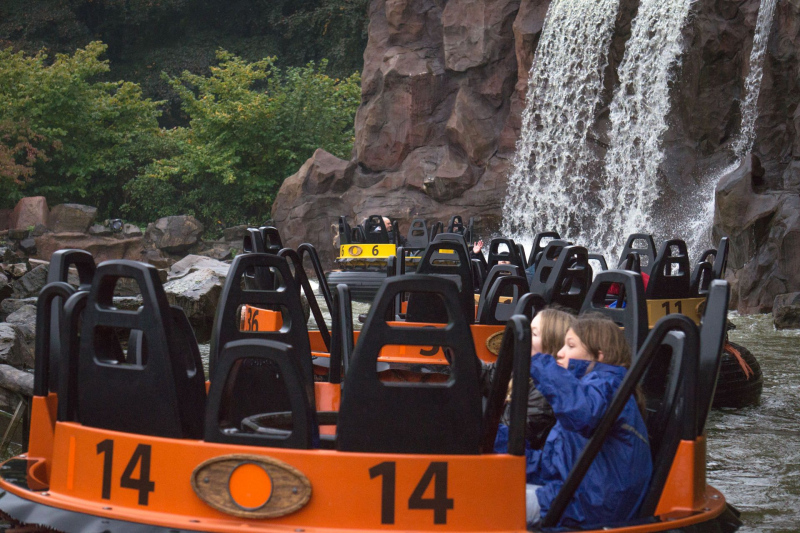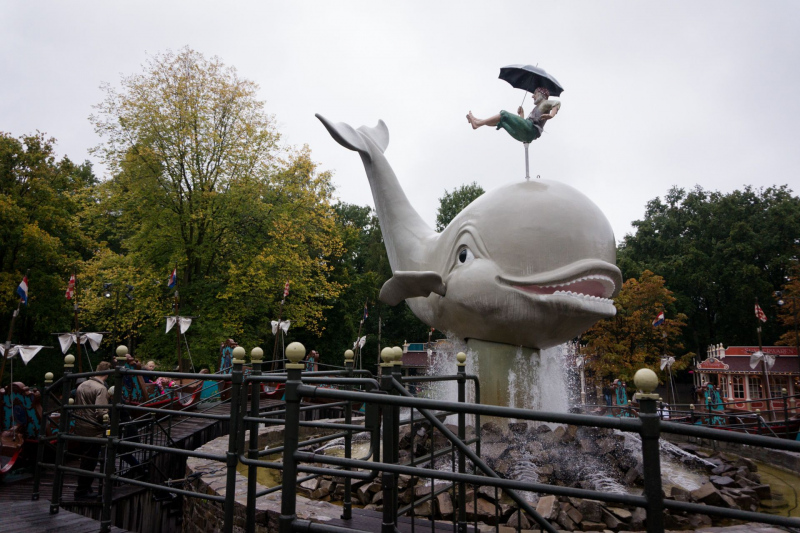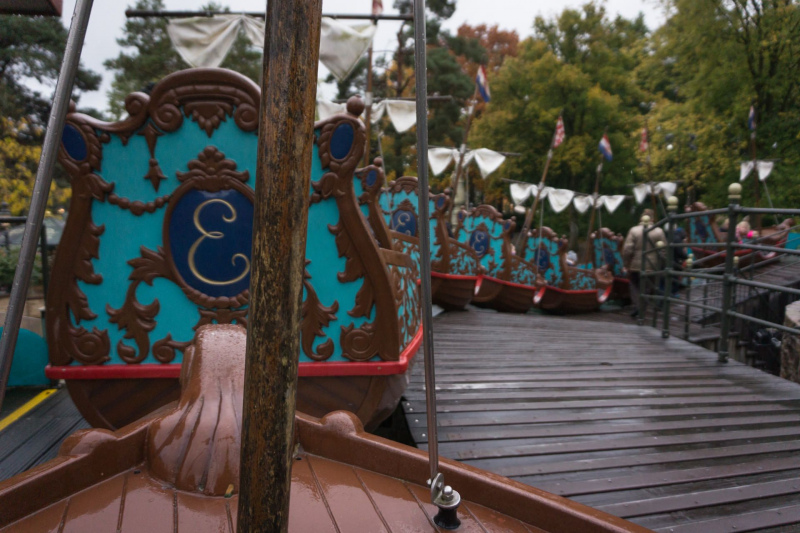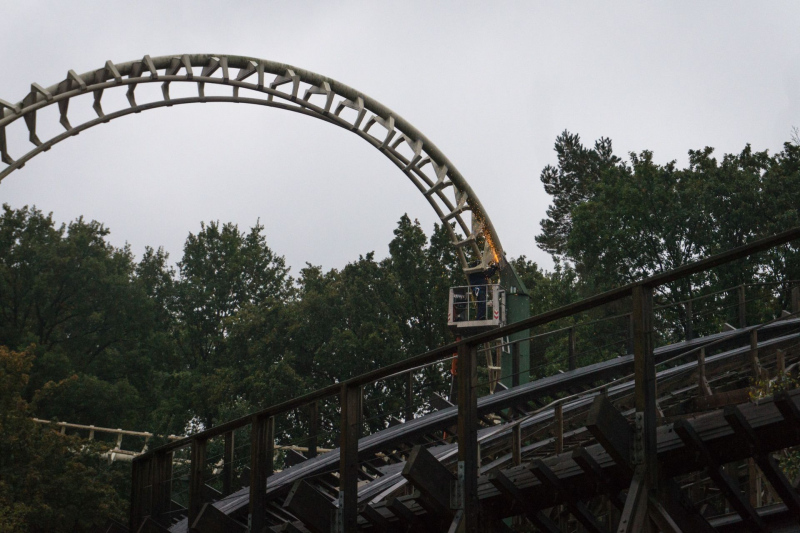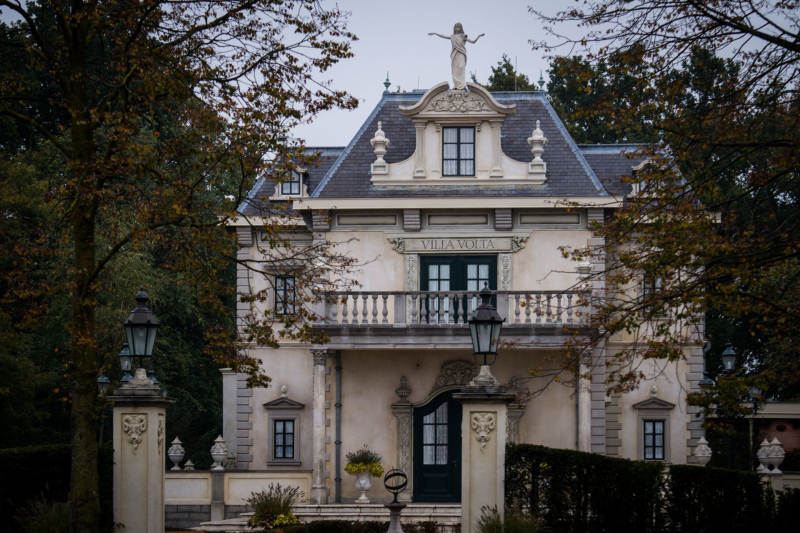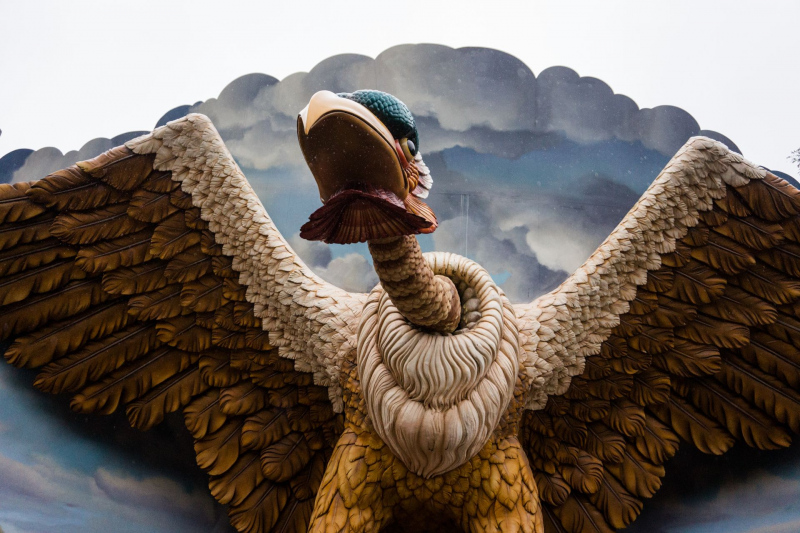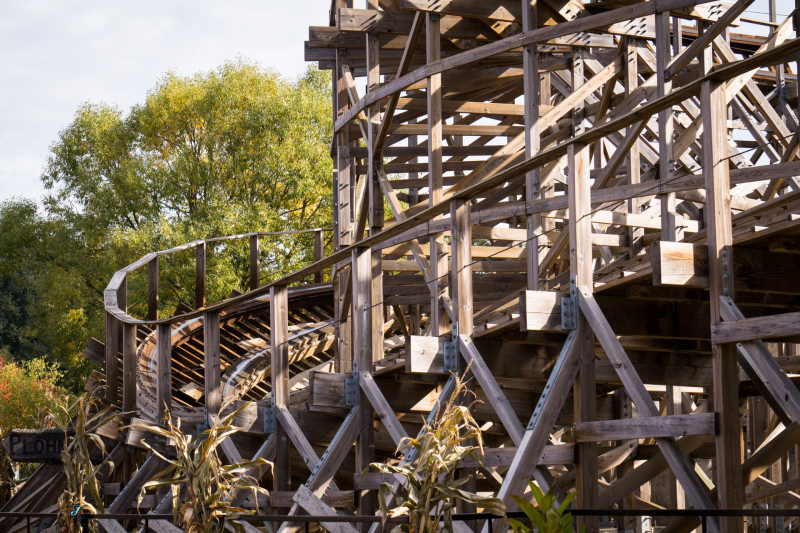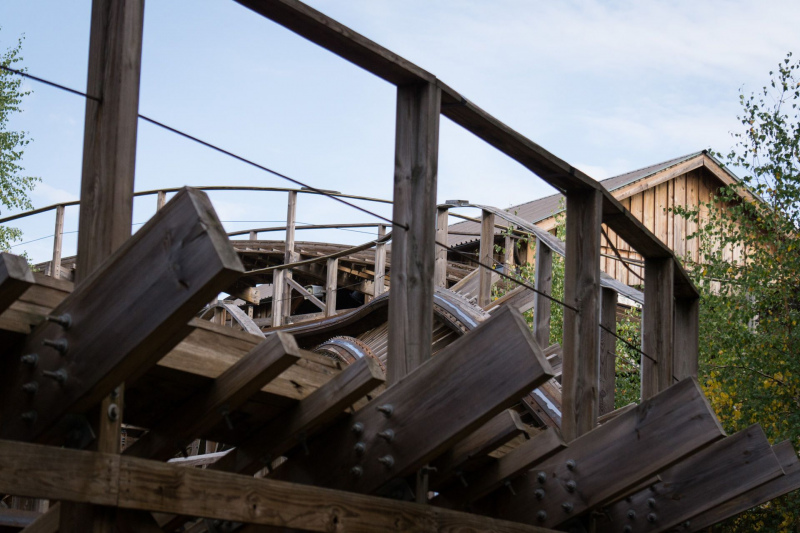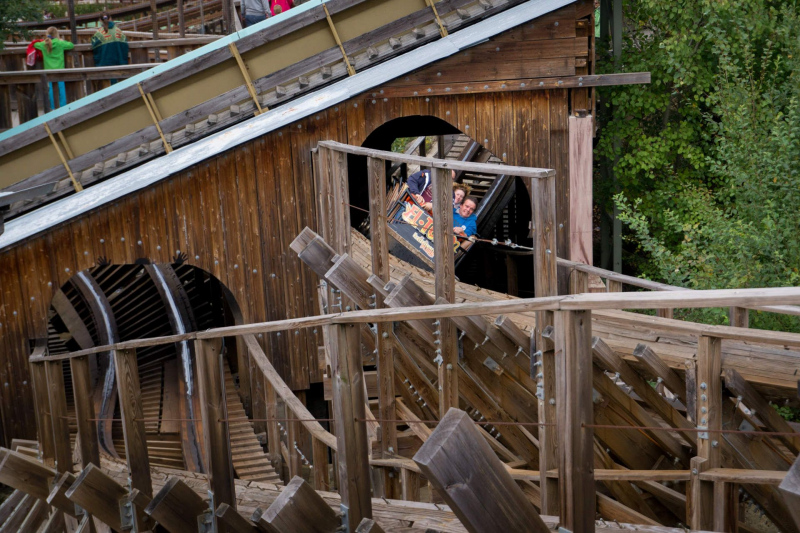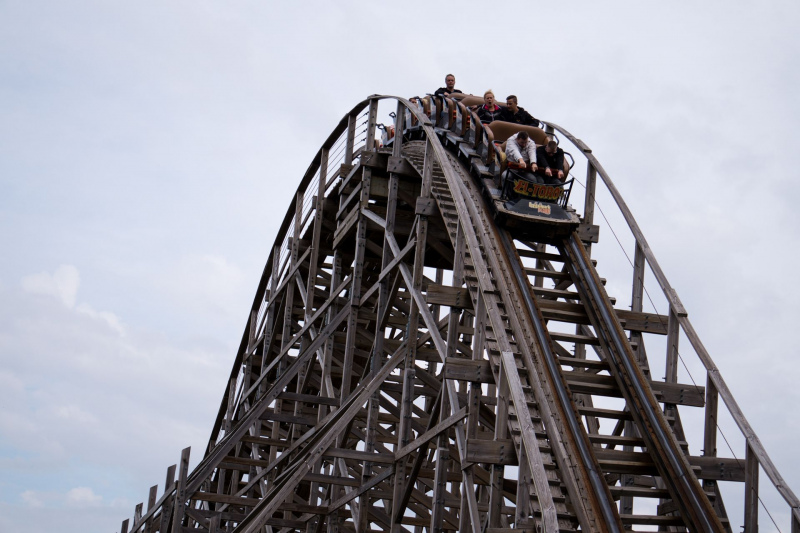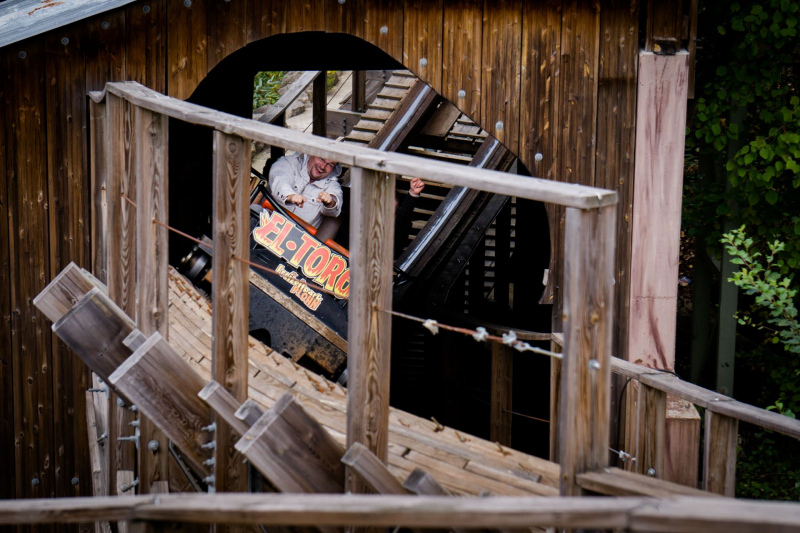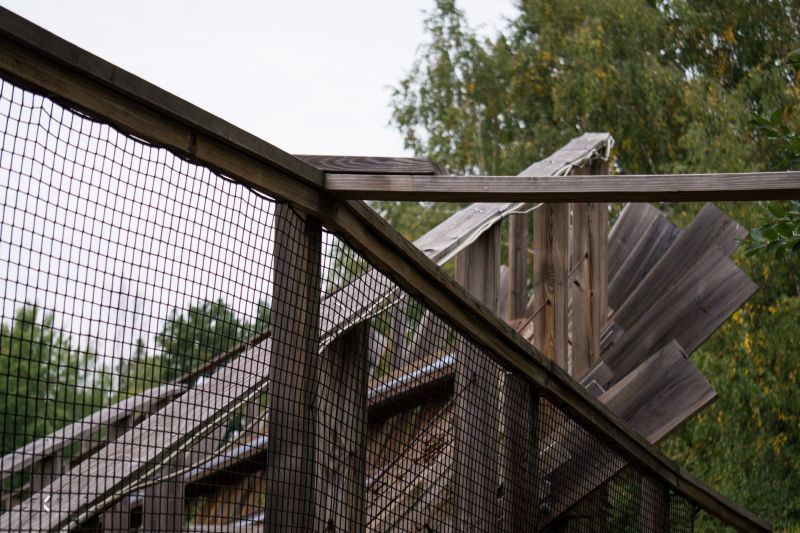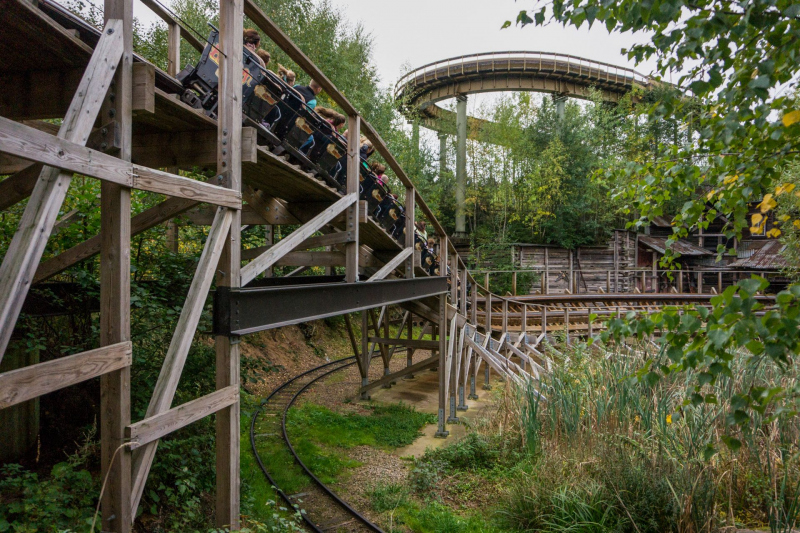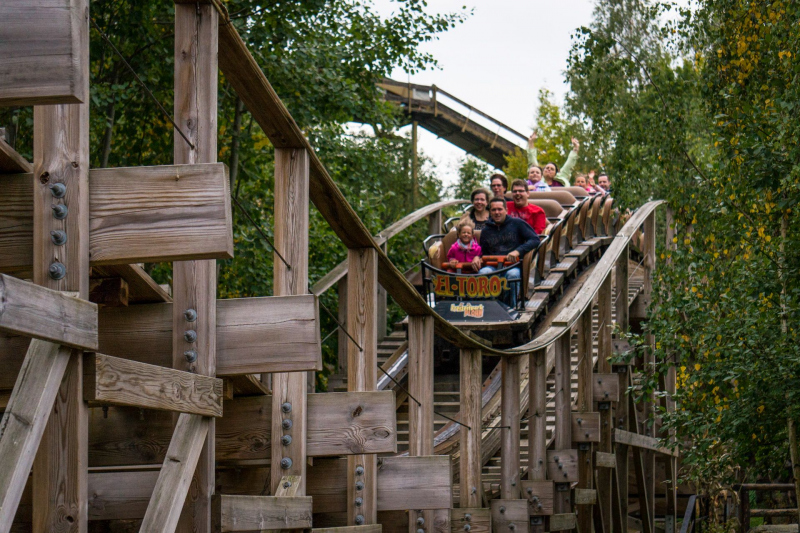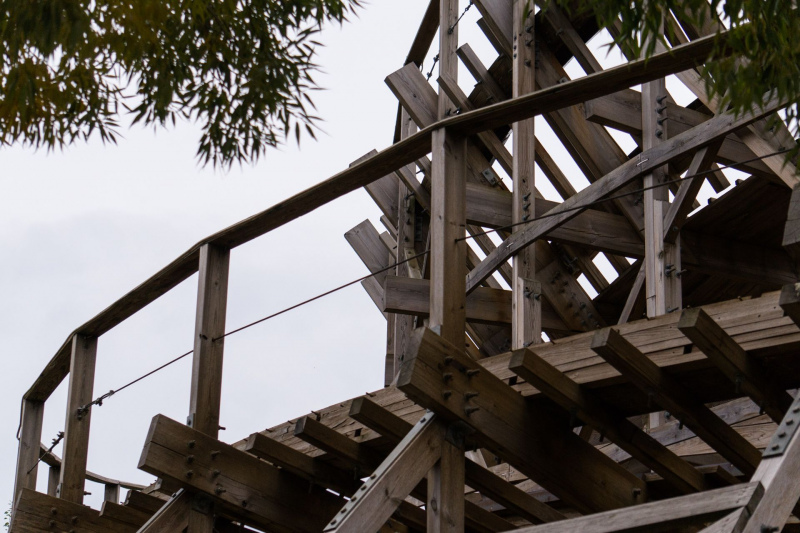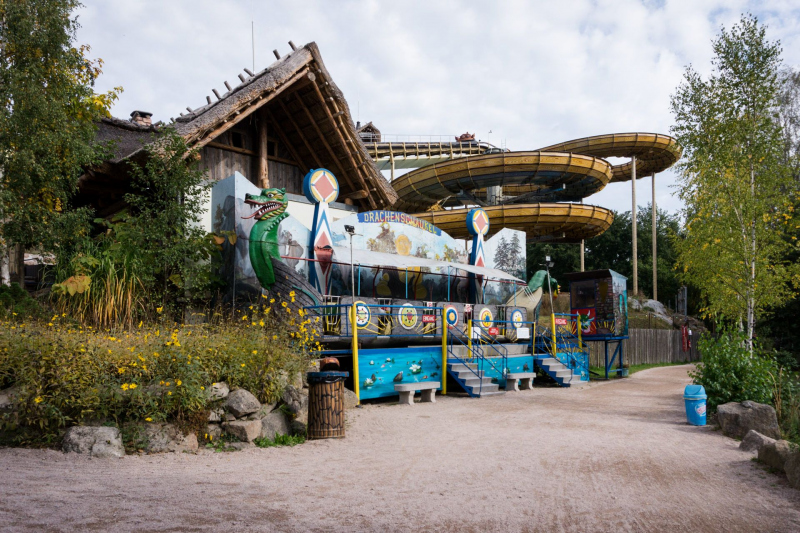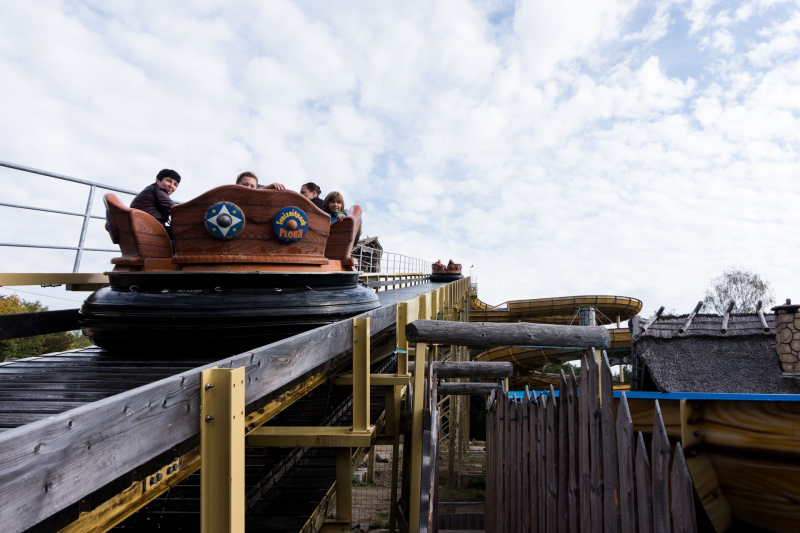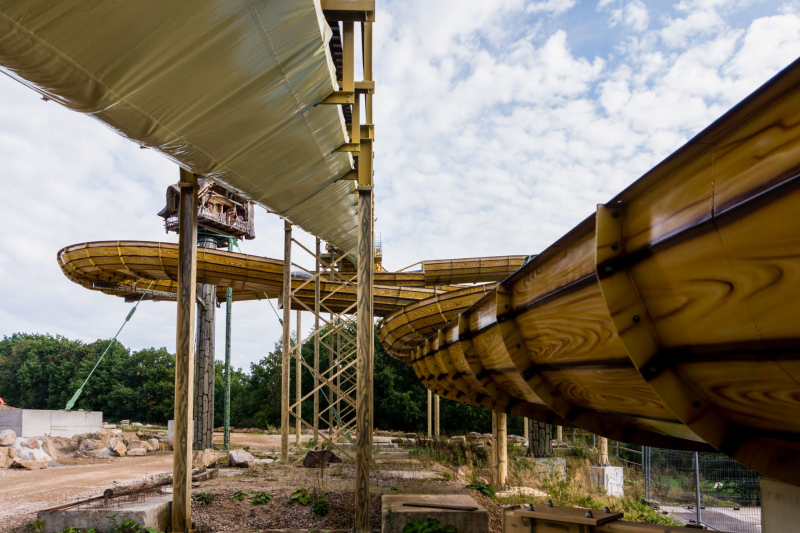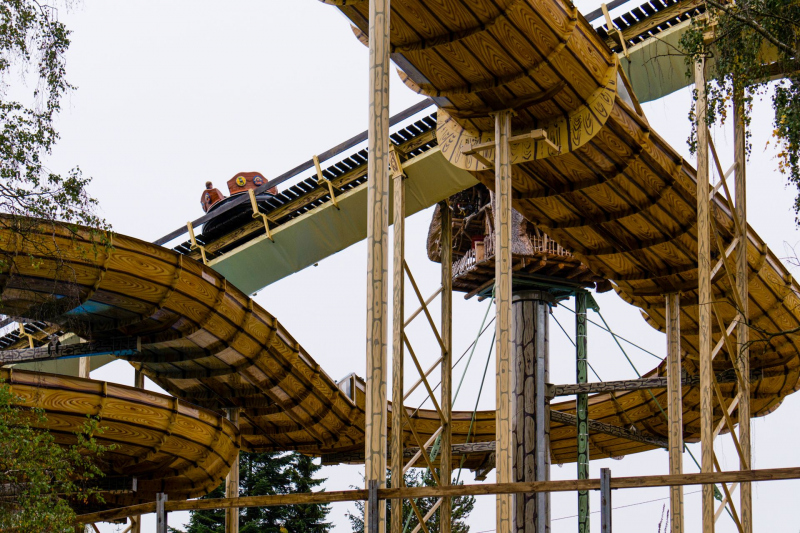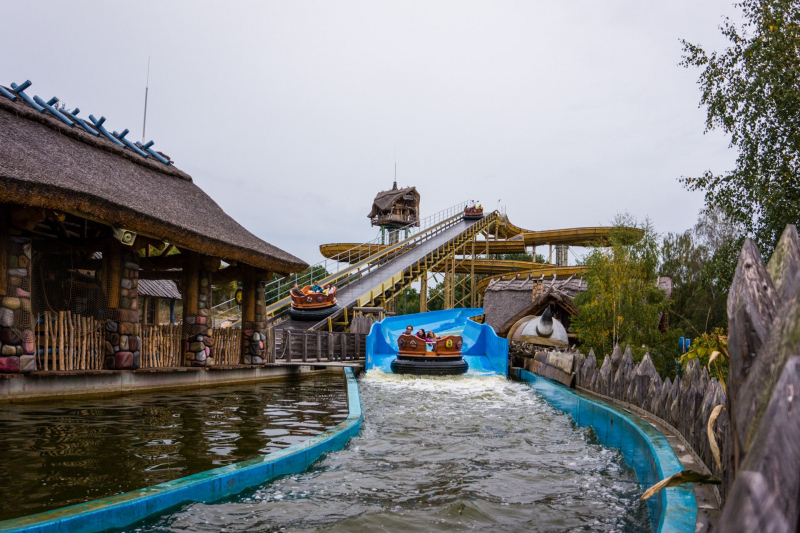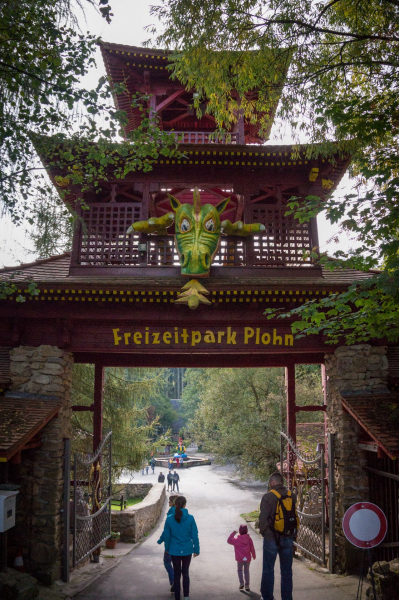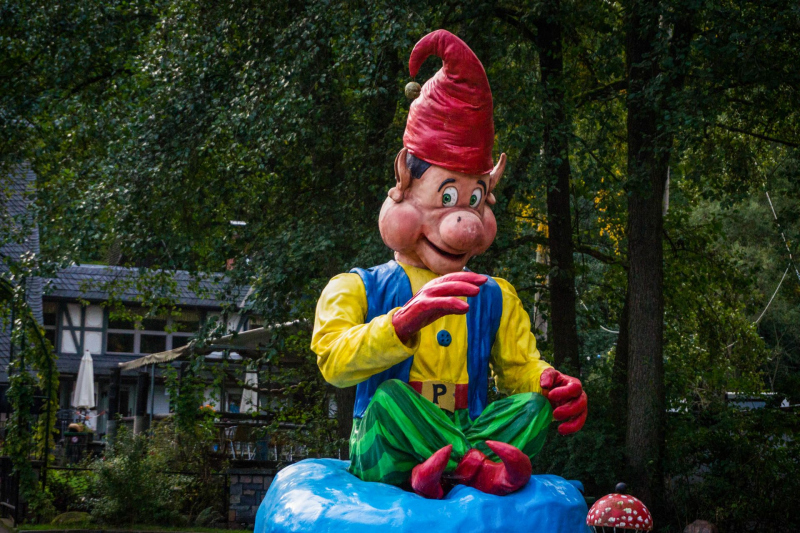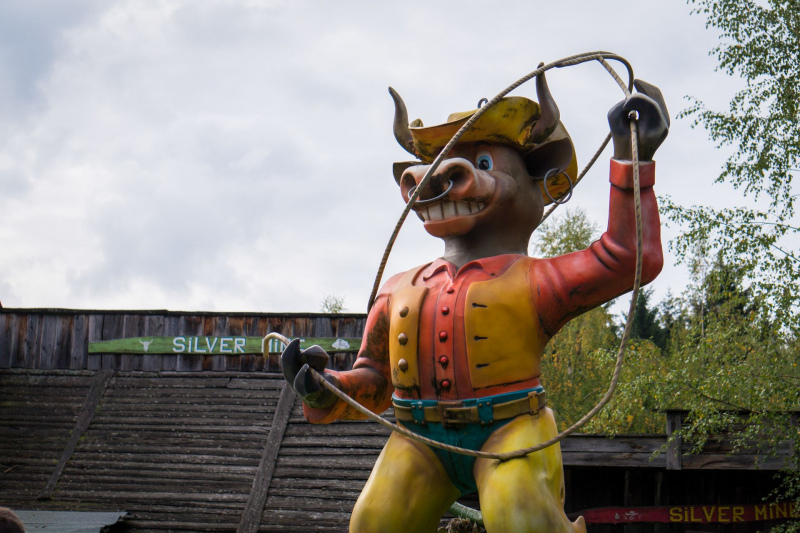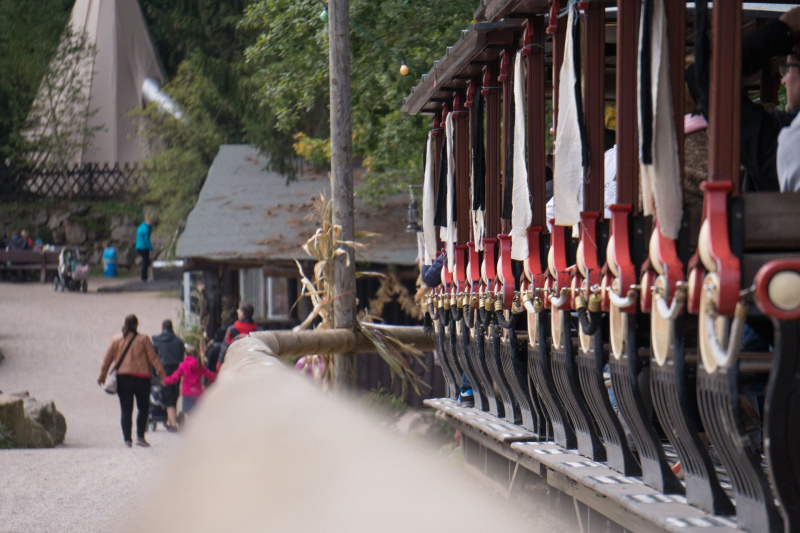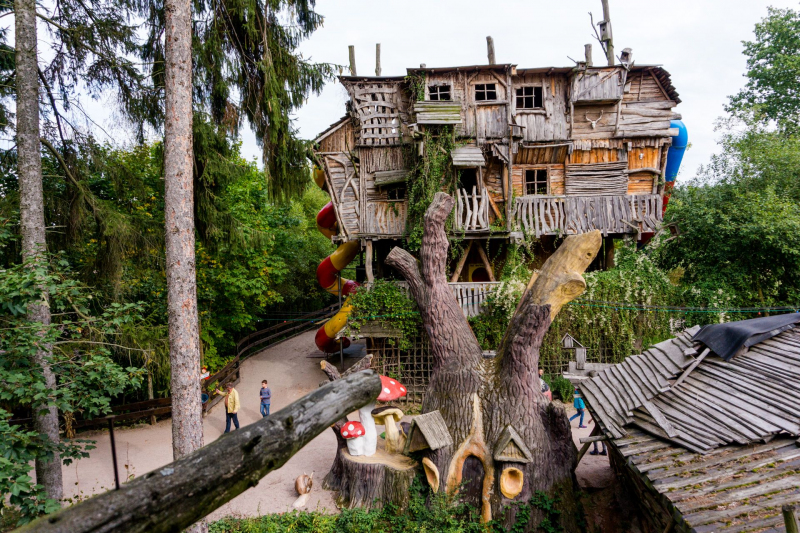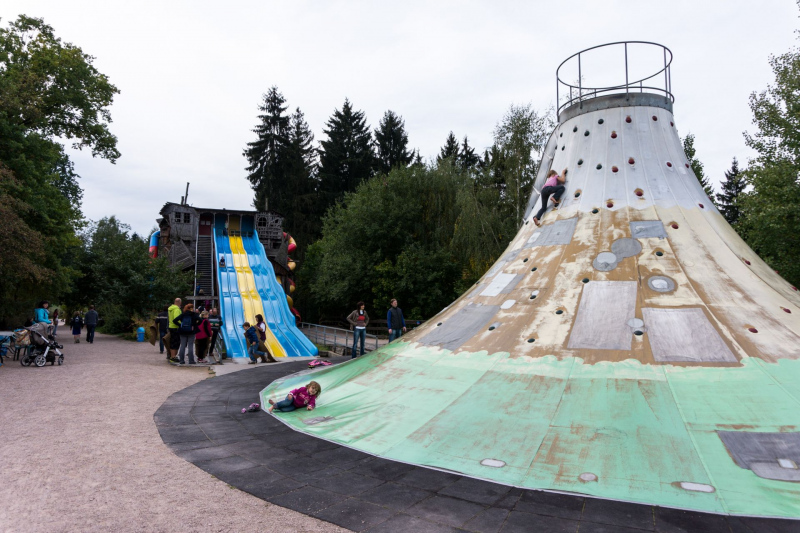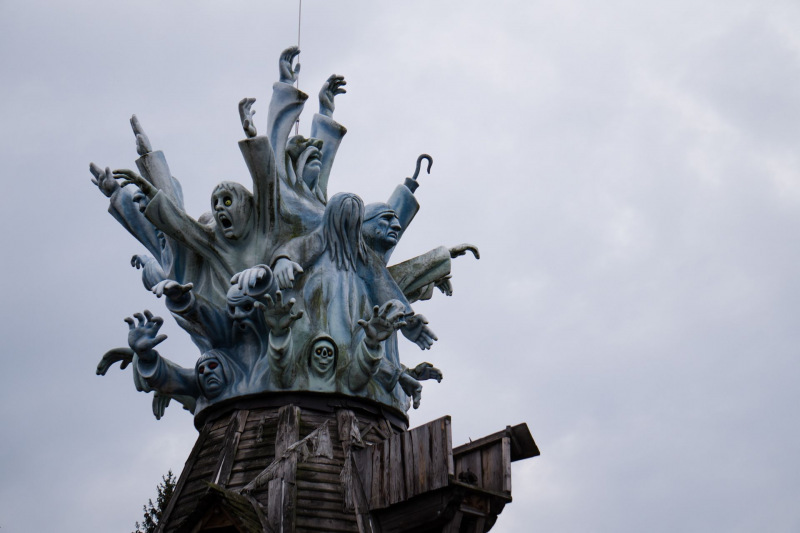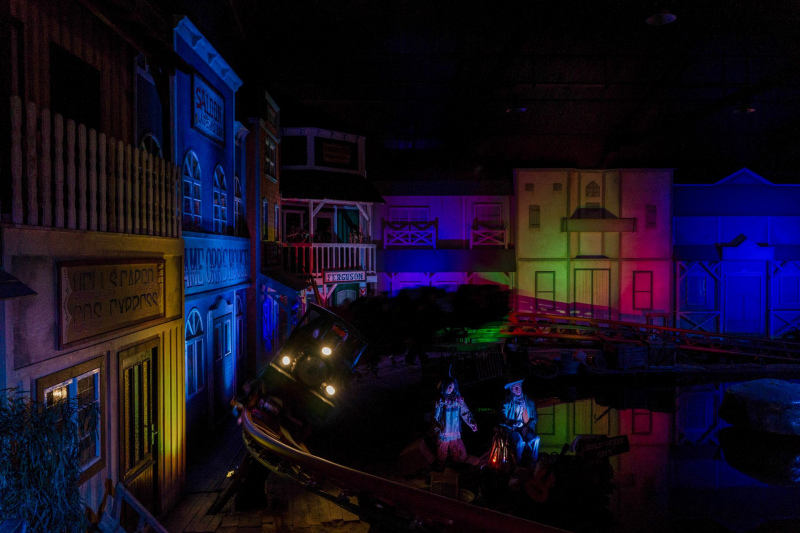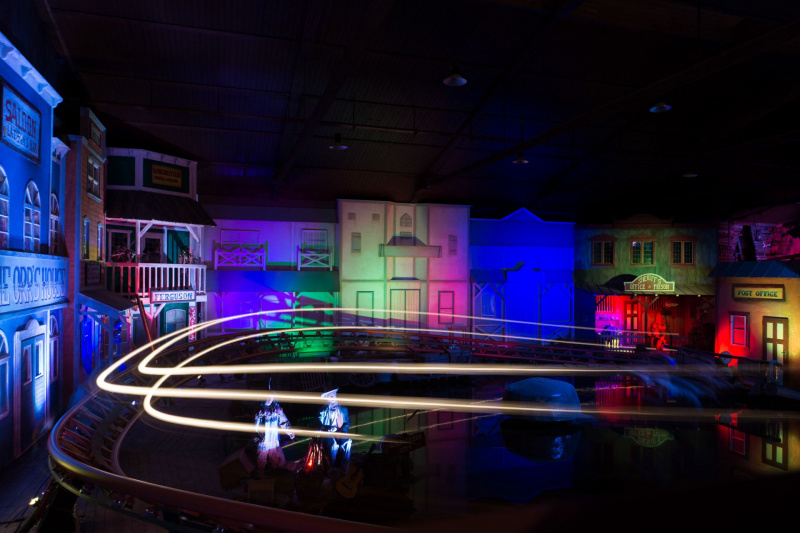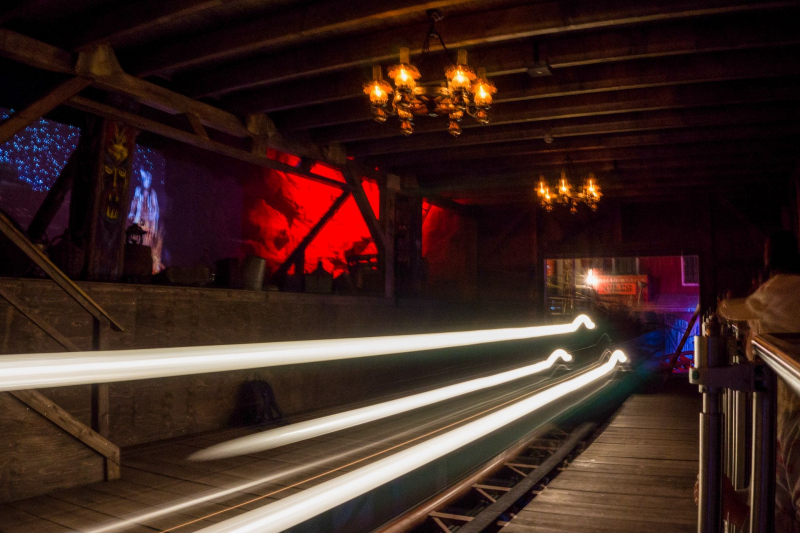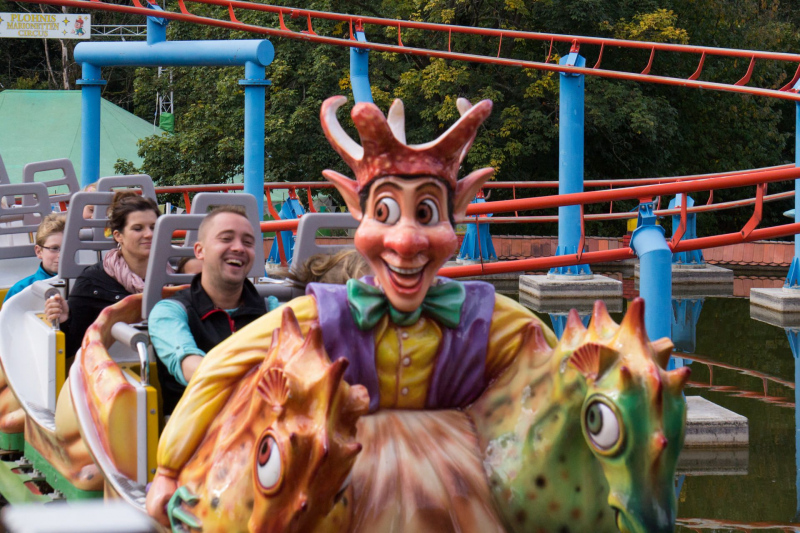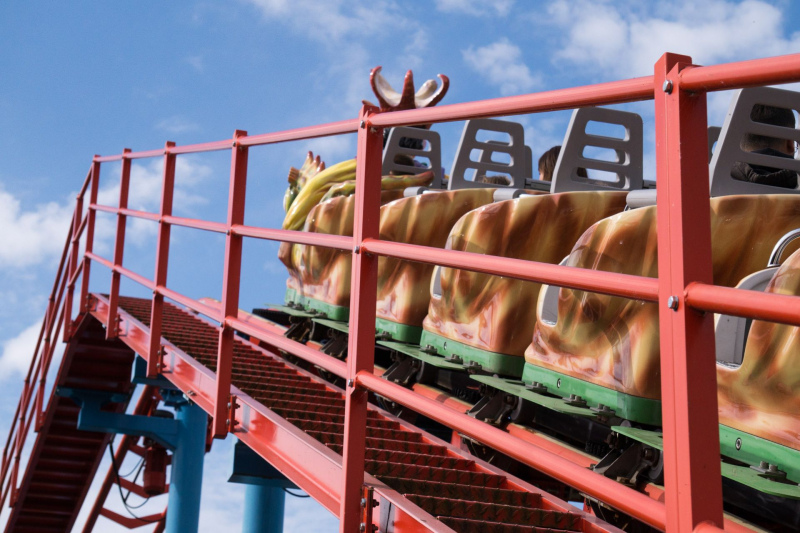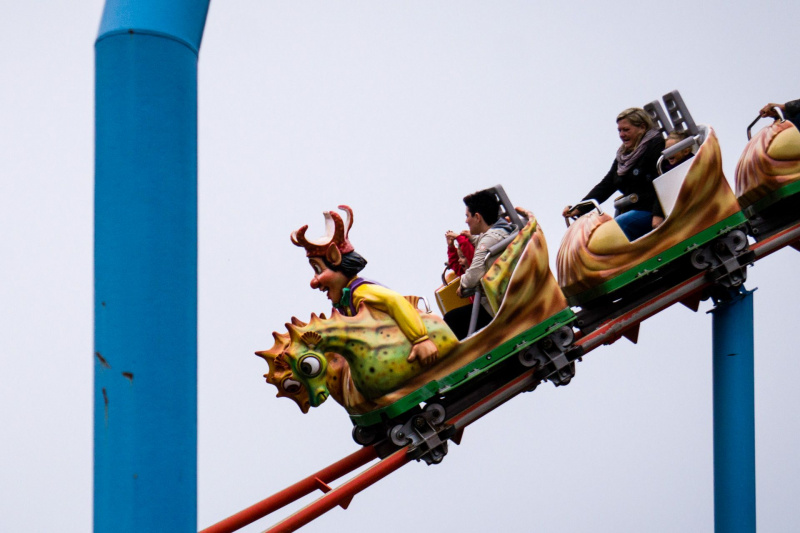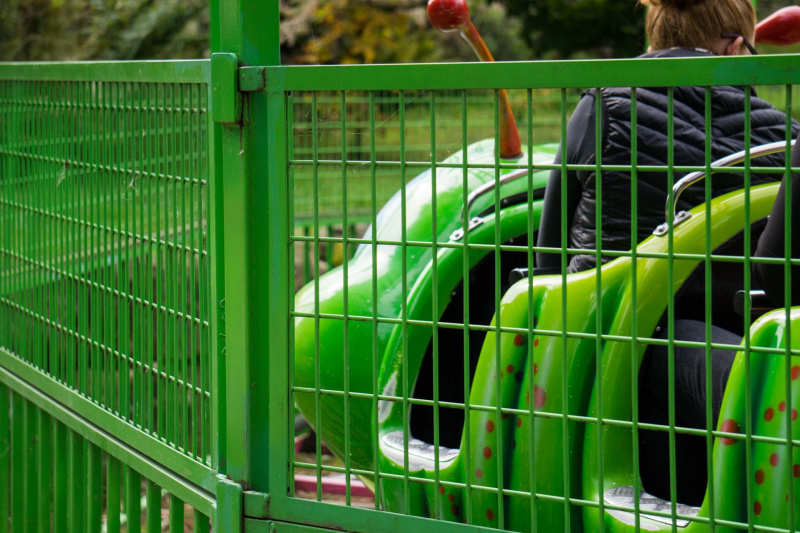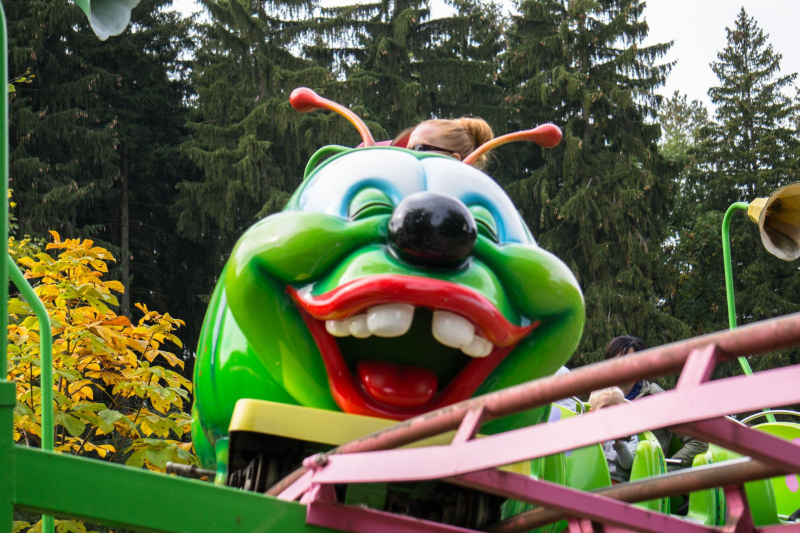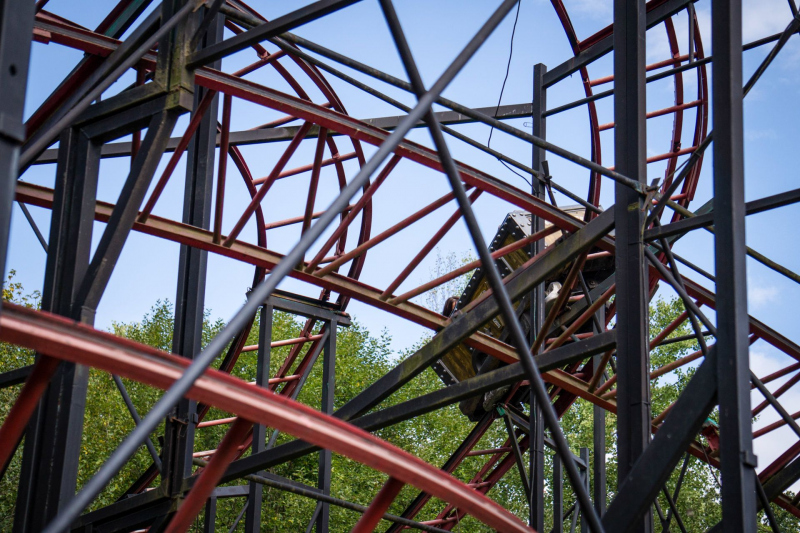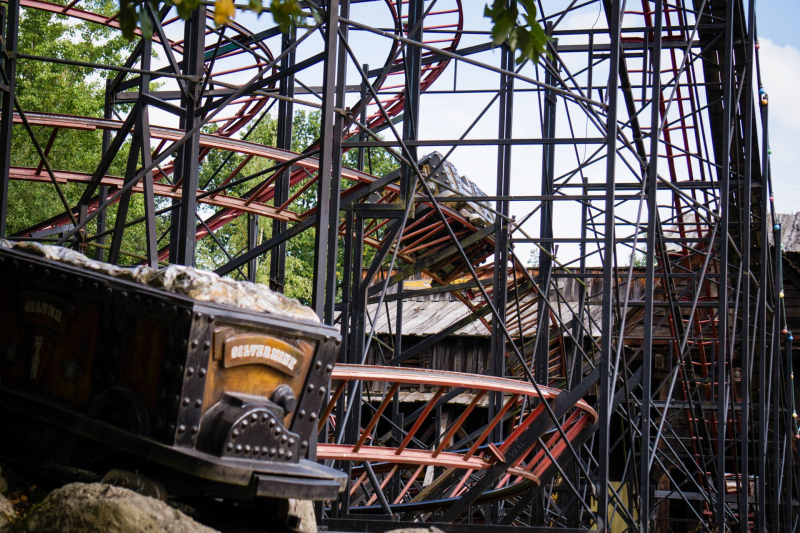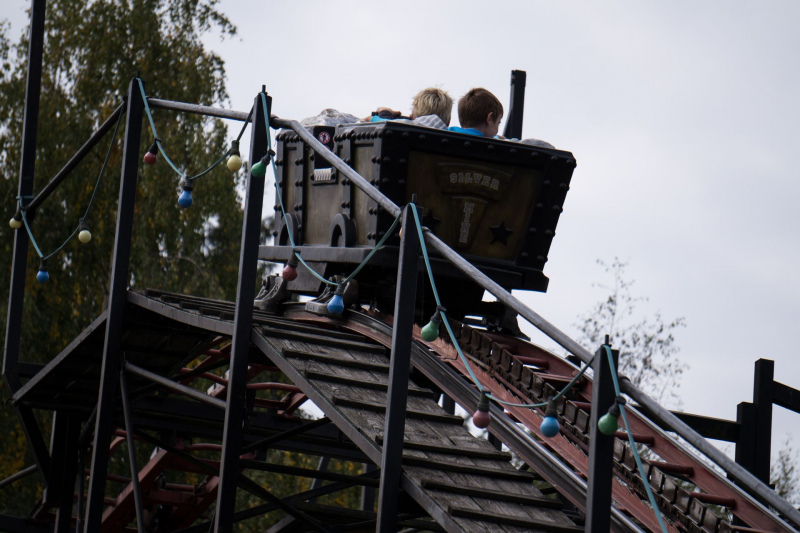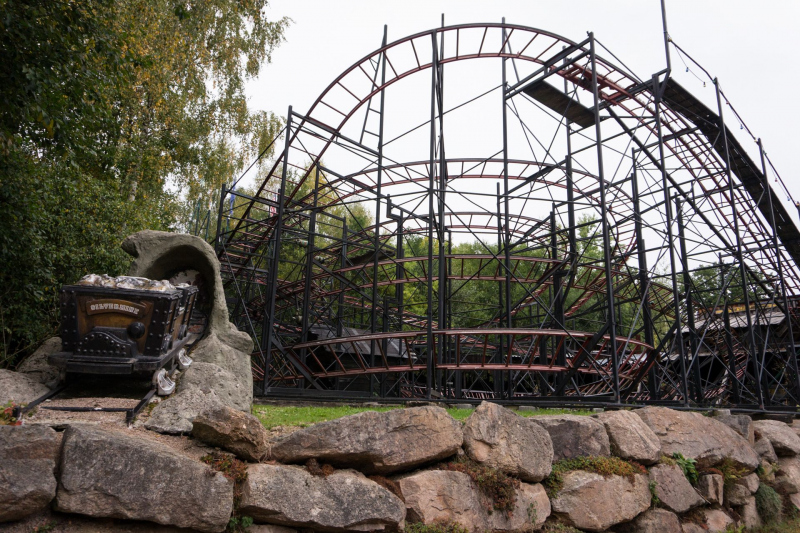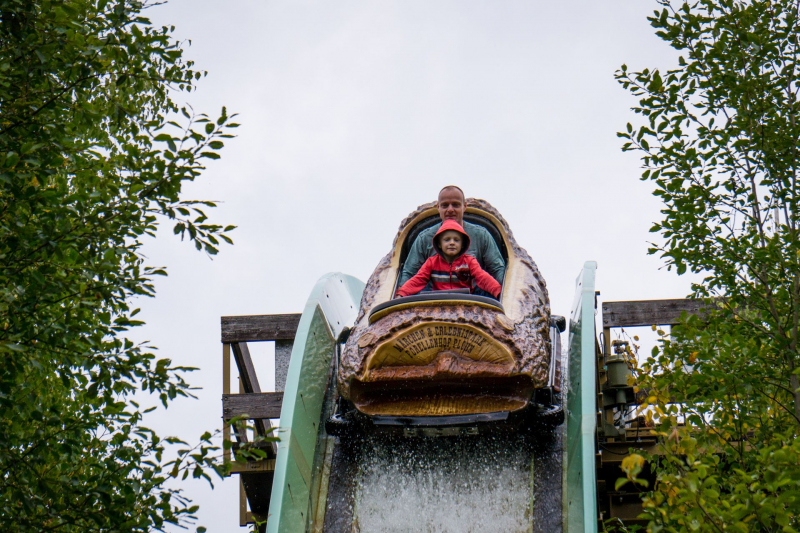Preface
Four years have passed to the day when I last walked through the gate of the Parque Warner Madrid theme park. At that time as part of a comprehensive tour of Spain with the, admittedly quite creative, name Coastern con Carne, now as the main reason to finally take a closer look at the Spanish capital Madrid. Decisive for this was the airline Norwegian Air Shuttle, which offers really low prices to Spain from Hamburg, as well as a meeting with Daniel (@Danieldikay), who is a student of the Spanish language and currently completing his compulsory stay in Zaragoza just 300 km away. The stay was booked through Travel Parks, the travel agency of Parques Reunidos, so we paid about 176€ for two nights in a Holiday Inn Express including breakfast and two entrances each for the Parque de Atracciones de Madrid and Parque Warner Madrid (each for up to 2 persons per ticket, as well as the possibility to go back to Parque Warner Madrid on the next day of the visit). A price that could hardly be lower without an annual ticket to one of the Parques Reunidos parks.
We stayed overnight in Alcorcón with good connections to the Cercanias Renfe, the suburban railway system of Spain, and the metro of Madrid. The journey to the Parque Warner Madrid turned out to be quite easy, only the departure from the park after midnight worried us. Via the central train station, and junction of all Cercanias Renfe, Atocha Cercanias, you can get to Pinto station quite quickly where you can take bus 413, which will take you directly to the park in a quarter of an hour. In the evening the bus takes you back to Pinto, where the last Cercanias Renfe back to Madrid leaves at 23:48. Another alternative had to be found, so we took the bus 412 to Villaverde Bajo-Cruce and got into the metro, which is still running until shortly after 2 o’clock.
Parque Warner Madrid
Theatro Chino 3D
After passing through the entrance gate you will find yourself on Hollywood Boulevard, the main street of the park. Here you will find some shops, some restaurants and the Theatro Chino 3D, a replica of the famous TCL Chinese Theatre on Hollywood Boulevard in Los Angeles. Besides the film Coyote y Correcaminos (a compilation of the last Road Runner and Wile E. Coyote cartoons), the film Marvin el Marciano en 3D (Marvin the Martian in the third dimension) is also shown here; especially the second film should not be unknown to visitors of the former Warner Bros. Movie World Germany near Bottrop Kirchhellen. It is about Daffy Duck and Marvin the Martian, and is of a surprisingly good quality for its age, especially with regard to the effects used. The film always looks like an old Looney Tunes cartoon and the story of it can entertain you very well.
Oso Yogui and Cine Tour
If you enter the park at the beginning of the opening hours, it is advisable to start your tour counter-clockwise and visit the Cartoon Village with all its attractions first. However, if you enter the park slightly later, you can expect longer waiting times, so a clockwise tour is the more sensible choice. The Movie World Studios are a wonderful themed area, where the theme of film, as in the entire park, now plays a much less important role than in 2011. While the Splash Battle Oso Yogui in its full splendour is still wetting the passengers down to their pants, the vintage car ride Cine Tour lacks all the figures from the Looney Tunes universe, so that in the end only a modest capacity remains on a somewhat longer ride. Here you also learn for the first time to hate the owners of Pase Correcamino’s Platinium wristbands, as they constantly pass before you.
Stuntfall
It’s only good that during the roller coaster Stunfall, due to an incident in which the train swung out in the first inversion figure and some rows, despite the existing platform, could not be evacuated easily, always runs with some blocked rows in the front and rear part of the train and therefore has a reduced capacity. Like at Shambhala in the Spanish Port Aventura, the train is almost exclusively filled with Pase Correcaminos owners, so that there is always a longer queue at this roller coaster. Stuntfall is a special kind of treat that you don’t want to ride only once.
After the corridor has been lowered, the wagon group is pulled backwards up a vertical tower. As soon as the tower reaches a height of less than 60m, it is released and thus puts its passengers in free fall before the train goes with full force towards the horizontal station passage. With rapid pace you approach the Cobra Roll, the first inversion figure of the track, and do two headstands. After you have left the element, a truly huge loop follows immediately, in which there is hardly any lack of pressure in the forward direction. Without any brakes you race up the second vertical tower, as well as the now synchronously running catch-car, which catches you and carries you up. By engaging the sled, the body is now at the upper end of the shoulder restraint and thus without any contact to the actual seat. The part that inevitably follows could have been the inspiration for the Schwur des Kärnan from the North German amusement park Hansa Park, but it is much more extreme, because on the one hand the incipient free fall is of longer duration and on the other hand it is only ended by the body in the middle of the looping by renewed contact with the seat shell. The loop is now traversed with pronounced pressure, whereas the Cobra Roll is traversed much more slowly. On the way back, you are caught in the tower by a catch-car, which is now also running synchronously, so you inevitably get to know the restraint and hang in it for some time. Shortly afterwards you will be driven back to the station.
The Giant Inverted Boomerangs are a really great invention. During the development process, the responsible engineers of the Dutch manufacturer Vekoma certainly took their breaks in the coffee shops in the area. The synchronously running sleds alone make the ride interesting, at least in terms of control technology. It is also quite complex, which is why it is already a miracle that Stuntfall makes its rounds without any major problems compared to the very error-prone rides of the same series. The ride on the Stuntfall is relatively smooth, but thoroughly intense and peppered with a great pinch of airtime without straining the body too much. All in all a great ride, where the crew has done everything possible to get the ride moving.
Hotel Embrujado
In a side street is the entrance to the Hotel Embrujado, a run-down hotel that seems to be cursed. Here the story of Isabella, henceforth referred to only as the bride, and Rikardo, her groom, is told. During a fire the night before the wedding, Rikardo died in the house’s secret library, access to which was at first not found; the bride, on the other hand, waited and waited and waited. Years later, an access to the library was discovered, whereupon the tragedy of the past days seems to repeat itself. A passageway leads from the library to the richly covered banqueting hall, but it is only a projection of days gone by. It gets dark and the bride awakes from the dead. Her mood sets the room in motion, varying from grief to despair and anger over the fact that Rikardo has left her. In the end she realises her mistake and chases the visitors away.
The Hotel Embrujado is a good Mad House with a well implemented storyline, but also a lot of Spanish visitors, so the atmosphere suffers from the general and quite loud chatter among each other. In addition, the queue inside the building moves very slowly, which is why a visit in the evening with much less crowd creates a much more atmospheric overall picture.
Parque Warner Beach
If you follow the main path, you are in an escape with the lift hill of the supposed main attraction of the park, at least the steel track would be according to our definition. But now we turn left shortly before and stand in front of the entrance of the water park Parque Warner Beach. It was opened in 2014 and offers new perspectives on the two roller coasters Stuntfall and Superman: La Atracción de Acero. Inside it offers a Lazy River and a larger wave pool. Fans of impressive water slides will not always get their money’s worth at Parque Warner Beach, as there are only smaller slide complexes or play structures with integrated slides from the manufacturer Van Edgom, including an interesting body slide with a funnel. The general design of the water park has been consistently implemented in the style of the Looney Tunes and Hanna Barbara (The Flintstones, Scooby Doo, Yogi Bear) figures and is worth seeing, even if the figures from the Cine Tour had to give up their place for this. Due to lack of time we were unfortunately not able to visit the water park, so I cannot say if it is worth the additional entrance fee. At least it seemed to be accepted by the population despite the end of the season. An extension with bigger and more appealing attractions would at least be desirable, but then also with an entrance outside the amusement park.
Superman: La atracción de Acero
As already mentioned Superman: La atracción de Acero is the supposed main attraction of the park, at least it is one of the bigger roller coasters of the manufacturer Bolliger & Mabillard, so by definition it is already better than good. At Parque Warner Madrid, on the other hand, the steel coaster has an average waiting time of only about 15 minutes, thanks to halfway competent staff and two-train operation, no matter how crowded the park got later in the day. It’s quite funny that many visitors don’t see the roller coaster with all its supports and rails and often clog the entrance of the queue with their pushchairs.
After the floor in the station has tilted to the side, the wagon group leaves the station and immediately completes a small turn in a typical Bayernkurve. Now the lift hill leads to a height of 50m, whereupon a small intermediate slope is passed before the actual first drop. Shortly afterwards, the train disappears towards the ground and the body reacts sluggishly. Almost continuously without any contact to the seat shell you fall down the drop to find your original seat again shortly before entering the loop. This is passed relatively quickly and thus with clearly pronounced forces. The following valley is crossed with full force just before you climb the Immelmann. A Trim Brake in the next valley reduces the train noticeably, which makes the Zero-G Roll, an inversion figure in which one turns around one’s own axis without any acceleration, quite pleasant to ride. This is followed by a generously designed Cobra Roll in whose exit you pass a second reduction brake. This is necessary because on the following hill you are transported out of your seat with extraordinary force. The first corkscrew is then entered in a straight line and after a short turn the exit of the first corkscrew is crossed by a second corkscrew, thus forming the element of the Interlocking Corkscrews. This is followed by a very intense curve close to the ground, whereupon the train takes another hill and carries the passengers up into the air again. An even more intensive upward helix follows, and shortly afterwards the brakes are reached.
Superman: La Atracción de Acero is simply brilliant. The ride offers everything a really good roller coaster needs, namely a great layout with its specific characteristics, in this case fast inversions and a balanced, although not lax, play of forces. The ride comfort is extremely good, although Superman: La Atracción de Acero is the ride with the most shoulder bar contact in the whole park and the condition of the trains in general is poor, as almost every headrest of this ride is now damaged.
Lex Luthor and Sillas Voladores de Mr. Freeze
Opposite the steel track, Lex Luthor, one of Superman’s opponents, bores his guests to death in a top spin with a lousy ride programme; interestingly, however, the ride is very popular with the park’s visitors. One of Batman’s opponents is much more fast-paced, however, as the Sillas Voladores de Mr. Freeze, a very nice wave swinger with an unusual design, offers a pretty good ride programme.
La Venganza del Enigma
High above the ground is La Venganza del Enigma, where you are transported to a height of 100m due to the Riddler, also a villain from the Batman universe. The 120m high Combo Tower of the company S&S has in theory three different modes. On our visiting day two lanes were operated in Space Shot mode and the third lane, which only functions as a turbo drop, was closed although the waiting area was quite well filled towards the end of the day. While I described the ride in 2011 as a damn high observation tower at best, I have to revise my opinion now, because the ride, perfectly placed in the park, can do more than just look good. The launch in space shot mode pulls surprisingly strong and just as long before you reach the maximum height and are lifted out of your seat a little bit. Up here you have a wonderful view of the underlying Parque Warner Madrid and theoretically of the Spanish capital before commuting at a leisurely pace. At least it is no comparison to other Space Shot rides and so La Venganza del Enigma is quite high in my favour, especially since it is the only tower above 71m height that is still fun to ride.
Batman: La Fuga
On the other side of DC Super Heroes World is Arkham Asylum, Gotham City’s asylum, where a large number of the most famous and dazzling Batman opponents decided to escape at the same time. As Dark Knight, you’ll have to catch them again. On your way up to the station of the Inverted Coaster Batman: La Fuga, you can explore the asylum from the inside. This can, if the ride is operated in the move-in mode, due to the minimal number of employees and surreal-looking processes, sometimes take a little longer.
After you have boarded the train and it has finally been checked in, the journey can start immediately. You don’t spend much time on the lifthill before you make a small predrop and get pulled into a steep curve. With immense force you pass the first valley and are immediately pushed into the first loop. Before you know it, you’ll be upside down again in the following zero-g roll. Without mercy, you now perform another loop, whereupon a left-hand upward helix introduces the supposedly most harmless part of the layout. But as soon as you make the turn at a lofty height, you no longer feel your legs. A steep turn brings you back to ground level, whereupon the first corkscrew is introduced. Especially in the rear part of the turn you pull through the element with quite high acceleration. After a rather tight turn you are again standing upside down in a corkscrew, whereby the play of forces of the first corkscrew is presented here even more intensified. After an upward left turn you reach the brakes and shortly afterwards the station.
Batman: La Fuga is short, not very high, but distributes the G-Forces like no other coaster; at least in Europe. The 11 sister installations, 6 of which have a similar theme, on the other hand, are burdening the passengers in the most positive sense in the rest of the world, but mostly in North America and there from time to time also backwards. Batman: La Fuga is a great roller coaster through and through, even though it is a very intense roller coaster, which is why it wouldn’t be a pity if, besides the current renaissance of the Suspended Looping Coaster by the Dutch company Vekoma, other rides of this kind were built by Bolliger and Mabillard.
Passing through the beautifully designed Gotham area of DC Super Heroes World, the tour will take you past the bumper car Los Coches de Choque de el Joker and the former simulator Batman: la Sombra del Murciélago, which had its last season in 2014 and may be replaced by a Justice League style dark ride, into the Old West Territory. Here you will find the break dance Los Carros de la Mina, as well as the two water rides Cataratas Salvajes and Rio Bravo.
Cataratas Salvajes
The wild waterfalls, i.e. the Cataratas Salvajes, are a very efficient and in my opinion very beautifully staged spillwater from the company Intamin. The efficiency of the ride is simply based on the simplicity of the layout, which is an oval without unnecessary frills. So after the boat has been transported up the lift hill, it makes a turn at lofty heights and immediately plunges down the only shot of the ride. This creates a large wave, which is then showered down on the boat’s occupants or moistens the daring passers-by on the bridge over the lane. The degree of wetness of the ride is relatively high already, but on average it is on a par with other rides of this type.
Coaster Express
The roller coaster Coaster Express is the only roller coaster of the park which can show an eventful history after the American Six Flags group as the operator of the park was discontinued. Like Bandit at Movie Park Germany, the ride started as Wild Wild West, designed to match the movie of the same name from 1999. As this movie was a flop without equal and meanwhile, partly unjustified, is considered as one of the worst movies, it was decided not to use the licence for the roller coaster and the theme area of the same name any longer when the park changed its operator to Parques Reunidos in 2005. The oversized queue underneath the station was shortened to the outside area and the space is now used for other purposes, but you can still have a look at the train with the ejection seat from inside the station.
After leaving the station, you cross the transfer track for a short time, whereupon a left turn follows. The train then hooks into the chain and is transported up the lift hill. Arriving at a height of about 36m the train immediately turns into a wide right turn, which turns out to be a 590° helix. The speed in the valley is about 80 km/h before it starts to rise again. At a higher level, you now wrap around the First Drop until you reach the ground again. A longer straight section is followed by a small right bend at a lofty height, after which a wide straight drop joins. Now you make a higher right turn, which at the same time changes into another drop. Here you make the second and last change of direction of the layout, because shortly after that you cross another transversely inclined helix, but this time leading left and only 520° wide. This is followed by a hill relatively close to the ground, whereupon another left turn follows. This is joined by another hill across the support structure, on whose descent there is a reduction brake. This brake is noticeably effective, which is even useful in the following and quite funny curve; it was exactly this curve which set the maximum size of the passengers to a comparably low 1m85 until a few years ago. Shortly afterwards the brakes engage and the train returns to the station.
While on my last visit in 2011 I had warned against getting on the ride at all and described the ride as a torture, I have to say that the Coaster Express is a pretty funny roller coaster and not to be missed. Although this wooden roller coaster offers absolutely no noticeable negative forces, the feeling of speed in the curves is very strong; at least the ride made me laugh almost all the time. The ride characteristics on Europe’s longest wooden roller coaster are generally good and the ride looks good from the outside.
Rio Bravo
The Reversing Boat Ride Rio Bravo from Intamin is a copy of the Hopkins ride Wild West Falls from the original Warner Bros. Movie World on the Australian Gold Coast, but is based on the original design idea after the movie Rio Bravo. So you can enjoy the ride all the more, because it has been thematised down to the last detail.
After crossing the long queue you can take a seat in one of the boats, at least in the evening. To my astonishment the seat belts have been abolished in the meantime, which at least adds to the capacity of this quite popular attraction. Shortly afterwards the boat bobs past the maintenance hall of the ride towards the first lift hill. At the top you enter the huge mountain range, where the first turntable is waiting for you. The turntable then releases the boat into the first shot, which is done backwards. So far so good and often experienced, but Rio Bravo wouldn’t be an extraordinary log flume if there wasn’t a special feature following it. For many people, it is often very unexpected to see a camelback coming up, which will take you 10-20cm into the air on its crest. Shortly afterwards the descent into the cool water follows, whereby the degree of wetness is still very manageable. After a bend, you reach another turning point, whereupon the boat is on its way forward again. The river now leads you through a canyon, an Indian village and the western town of Dogde City, before you enter the mine again. Arriving at the highest point of the ride, you are brought back into position by a turntable, whereupon the second and final shot ride is initiated with a fantastic view of the wooden roller coaster Coaster Express. Once you arrive at the bottom you will be pleasantly moistened. This is followed by the return trip to the station.
The Rio Bravo log flume is a great ride with a bigger element of surprise at the beginning of the ride. The general design is terrific, but it lacks a bit of effects after leaving the second turning point. Although I don’t ask for buckets of water to be thrown in my face like on the magnificent log flume Valhalla from the English Blackpool Pleasure Beach, a little more would have been possible here, especially since the other water rides of Parque Warner Madrid are all wetter.
Tom y Jerry
You can hear the Tom y Jerry children’s rollercoaster at Parque Warner Madrid from far away, as the ride sounds like a jet plane flying over the park. This is one of the last Zierer Tivoli large coasters produced, which was commissioned by Six Flags at the turn of the millennium and therefore has supports that meet the clearance gauge in comparison to the rides from the 1970s, which are often to be found in Germany. The layout can be described relatively simply as two adjacent eights, in which the rather wide curves are negotiated by a train that is all the longer. Mostly the course will be ridden through several times, but not at Parque Warner Madrid. Otherwise the waiting time at this very solid roller coaster would be hard to control, because Tom & Jerry is one of the most popular rides at Parque Warner Madrid.
Cartoon Village
However, this generally applies to the Cartoon Village theme area with its two children’s lands and the Rápidos Acme rafting. It is true that the situation in Spain is not quite as extreme as in England, where basically only well-known, or for us sometimes completely unknown, children’s series bring the masses into amusement parks. Paultons Park has shot the bird with the Peppa Pig World, so that it is only known to the public as Peppa Pig World and various advertising brochures can already be found in Scotland. In Spain, on the other hand, although the children’s areas are more important, other visitors also come to the park and are spread over the other theme areas of it, although this proportion has increased significantly in recent years.
What is interesting about the Parque Warner Madrid children’s areas, however, is the way they are designed. One area was completed for the opening in 2002 and the other in 2011, with the roller coaster Correcaminos Bip, Bip from 2009 being halfway integrated. While the old children’s area has countless rides in a narrower area, always in the shade of countless trees, the new area has few rides in a larger concrete area without any shade. Although these are all neatly arranged, there is no atmosphere whatsoever in this addition. What is interesting here is that almost every new plan park has these patterns, which in my opinion is a no-go. The Academia de Pilotos, a children’s monorail from SBF Visa from 2013, has at least tried to break up this situation.
Correcaminos Bip, Bip
The roller coaster with the supposedly strange-sounding name Correcaminos Bip, Bip is a Youngstar Coaster by the company Mack, which has the same layout as the one year younger Götterblitz from the Austrian Familypark. Just like at Lake Neusiedl, the ride begins with the ascent of the lifthill. After reaching the top of the lifthill, a small gradient leads into the first curve, followed by the big drop. At full speed you pass the first valley and immediately a horseshoe, an element which is shaped like an elevated horseshoe. In a right-hand bend, you accumulate meters of altitude once again, whereupon these are reduced in a downward left helix with subsequent gradient. Now follows a curve combination of up and down helices, which resembles an eight when viewed from above. Finally, another right turn leads the train up to the braking section and then back to the station.
Correcaminos Bip, Bip is a very elaborately designed ride, but also a very unlovingly staged roller coaster with a great layout and equally good ride characteristics. It’s a bit of a pity to see that the hunt for the Road Runner, i.e. Correcaminos, is hardly visible from the outside because of the high wooden fences with peepholes. It’s also a pity that the ride is a stand-alone attraction in a dead-end street. But all of this would not be so bad if Correcaminos would not get on the nerves of the waiting people at some point due to his pass for the queue, the Pase Correcaminos. Although the queue is manageable, it takes half an eternity until it is your turn. So somehow you can understand Wile E. Coyote. However, he only caught the Road Runner at Family Guy.
Rápidos Acme
An extraordinary ride for Europe can be found in the park with the Rápidos Acme. Even if you find it hard to believe, you will get wet on this ride. Now you could argue that River Quest from Phantasialand in Brühl often releases its passengers completely soaked from the ride, but not everyone is affected. The secret recipe of the Parque Warner Madrid is as simple as it gets, as the park does without unnecessary gadgets like waterfalls or wave pools and instead concentrates on creating as many rapids as possible on a very curvy route, which constantly splash into the boat, while always directing water jets into the boat from the outside. The whole action is nicely designed by the characters of the Looney Tunes, but to be honest, you can hardly concentrate on them during the ride. Unfortunately the effects had all been switched off towards the end of the ride, which is a pity, but it was probably a bit too cold for the Spanish.
La Aventura de Scooby-Doo
Right at the beginning of the Cartoon Village, coming from Main Street, is the interactive dark ride La Aventura de Scooby-Doo. This was designed in the comic style of the Hanna Barbara series Scooby-Doo Where are you! and features the typical elements of this series. This ride was produced by the Sally Corporation and can also be found in two Six Flags Parks and previously in each of the Paramount Parks, but now under the management of Cedar Fair as Boo Blasters on Boo Hill. The ride itself should be experienced directly after the opening of the ride or with a corresponding Pass Correcaminos, because the handling of this dark ride is more than just a bad joke. In addition, Scooby-Doo itself is very popular with the local children, which is why the crowds at the ride are always relatively high. The ride at least is nicely designed and can be fun, but it is one of the weaker rides made by the manufacturer.
Although the rush at the big roller coasters was always manageable and appropriate, the park was very well visited. In fact, during the visit it seemed as if the park was almost overcrowded, this was mainly due to the general preferences of the Spanish and so it should not surprise anyone that the waiting time before each show was over an hour. This is also the reason why we left the Scooby Doo musical and the Police Academy stunt show. One could think that this was a big mistake, as the shows in Spain are generally not as negligible as those of German amusement parks, but on the other hand we could not have managed the park completely in one day. In fact, the offer of these at Parque Warner Madrid is also significantly lower than at the amusement park Port Aventura near Salou, whose recipe for success is actually due to the big show theatres. Here, the park might add another theatre or at least show the shows more often.
Parque Warner Cinematic
However, this does not work for the evening show Parque Warner Cinematic, as it only really comes into effect after dark. This is a fountain show with projections of well-known Warner Bros. films and commercials for upcoming films of the studio. The show, which takes place on the lake in the Movie World Studios, is supported by fire and laser effects, as well as a quite appealing final fireworks display. The show was already worth seeing on the occasion of the 10th anniversary of the park and even now not much has changed. Definitely worth seeing, especially as it is a great ending of a great park day.
Pictures Parque Warner Madrid
Conclusion Parque Warner Madrid
Parque Warner Madrid is still a very great theme park and in my opinion still the best park in Spain. Compared to four years ago, the number of visitors has developed quite well, which unfortunately makes the Pase Correcaminos very annoying, especially since it can be used almost everywhere, unlike Port Aventura. Except for Batman, which features a one train operation, the handling was much quicker than before and in the case of the roller coaster Stuntfall even exemplary. At least for the time being one is on a good way that should be maintained. But if the rush should be as high on the next visit, I will definitely treat myself to a Pase Correcaminos.
What is your opinion about the spanish theme park Parque Warner Madrid? Just write it here below the report in the comment field or visit or our social media channels:

